DAIRY ST R
Volume 24, No. 24

Volume 24, No. 24

VESPER, Wis. – Taking over his family’s dairy farm was not the career path Travis Marti planned to take when he graduated from high school; eventually, though, it turned out to be the piece of the puzzle he felt he was missing.

Travis and Melissa Marti have worked at putting the pieces of their puzzle together as the third generation at Marti Farms with their children Allison, Chloe, Jacob and Ryan.


MAURICE, Iowa – A trio of northwestern Iowa dairy operations are teaming up to install a pair of anaerobic digesters that will make methane from their cows’ manure.
In a unique twist, the renewable natural gas produced by the dairies will be sold directly to the nearby town of Sioux Center.

The three dairy farms include Maassen Dairy, which is milking about 2,000 head; Brian Roorda Dairy, which is home to about 1,500 head; and Hoogland Dairy, an operation that has about 3,000 head.
Their diligence paid off when the couple was named Wisconsin’s 2023 Outstanding Young Farmers Jan. 28 in Manitowoc.

The title has special meaning for the young couple because of a family legacy: Travis’ parents, Mick and Kitty, were the Wood County OYF winners in 1988, and his grandparents, Ron and Arlene, were also named Wood County OYF winners in 1966.
The farm is home to 500 cows that are milked in a double-10 parlor. The cows are housed in a 4-row tunnelventilated barn that is sandbedded and cleaned with alley scrapers. The herd currently averages 96 pounds of milk per cow per day with 4.25% butterfat and 3.3% protein
Turn to MARTIS | Page 6
be installed between Maassen Dairy and Brian Roorda Dairy. One pipeline will carry manure from Brian Roorda Dairy to the Maassens’ digester, while the other will carry the appropriate amount of digestate back to Brian Roorda Dairy.
February 11, 2023

Aaron
Construction of the two digesters will begin this spring. It is hoped they will start producing renewable natural gas by mid-2024.
“One digester will be built north of our manure lagoon and will handle the ma-
nure from our dairy and the manure from Brian Roorda Dairy, which is located a mile away,” said Aaron Maassen, a fth-generation farmer who, with his family, operates Maassen Dairy.
A pair of 6-inch pipes will
The second manure digester will be built at Hoogland Dairy. The Hoogland Dairy digester facility will also feature a renery that will remove impurities from the raw methane. The resulting product will be no different than the natural gas that is obtained from traditional sources.
“The renery is the most expensive part of producing renewable natural gas from manure, so it makes economic sense to have just one renery to serve all three farms,” Maassen said. “A pipeline will carry raw biogas from our farm to Hoogland Dairy, which is located about 3 miles away. The puried renewable
natural gas will then be piped to Sioux Center.”
Ypsilanti, Michiganbased Novilla RNG will build the manure digesters at Maassen Dairy and at Hoogland Dairy. Novilla RNG has formed a separate entity called West Branch LLC that will manage the operation of the digesters and market the dairies’ natural gas.
“We were referred to Hoogland, Maassen and Brian Roorda dairies as great dairies that did not have an RNG project,” said Jared Williams, co-CEO of Novilla RNG. “When we were looking for a natural gas pipeline to inject the gas into, we saw that Sioux Center was nearby and had the capacity to handle the gas injection. Once we started working with Sioux Center, we were impressed by their speed and forward thinking and decided
“All dairy, all the time”™JERRY NELSON/DAIRY STAR
Published by Star Publications LLC
Mark Klaphake - mark.k@dairystar.com
320-352-6303 (ofce)
320-248-3196 (cell)
320-352-0062 (home)
Ad Composition - 320-352-6303
Nancy Powell • nancy.p@dairystar.com
Karen Knoblach • karen.k@star-pub.com
Annika Gunderson • annika@star-pub.com
Editorial Staff
Tiffany Klaphake - Assistant Editor
320-352-6303 • tiffany.k@dairystar.com
Maria Bichler - Assistant Editor
maria.b@dairystar.com • 320-352-6303
Danielle Nauman - Staff Writer
608-487-1101 • danielle.n@dairystar.com
Stacey Smart - Staff Writer
262-442-6666 • stacey.s@dairystar.com
Abby Wiedmeyer - Staff Writer
608-487-4812 • abby.w@dairystar.com
Grace Jeurissen - Staff Writer
320-352-6303 • grace.j@star-pub.com
Jan Lefebvre - Staff Writer
320-290-5980 • jan.l@star-pub.com
Amy Kyllo - Staff Writer amy.k@star-pub.com
Consultant
Jerry Jennissen 320-346-2292
Main Ofce: 320-352-6303
Fax: 320-352-5647
Deadline is 5 p.m. of the Friday the week before publication
Sales Manager - Joyce Frericks
320-352-6303 • joyce@dairystar.com
Mark Klaphake (Western MN)

320-352-6303 (ofce)
320-248-3196 (cell)
Laura Seljan (National Advertising, SE MN)
507-250-2217 • fax: 507-634-4413 laura.s@dairystar.com
Jerry Nelson (SW MN, NW Iowa, South Dakota)
605-690-6260 • jerry.n@dairystar.com
Mike Schafer (Central, South Central MN)
320-894-7825 • mike.s@dairystar.com
Amanda Hoeer (Eastern Iowa, Southwest Wisconsin)
320-250-2884 • amanda.h@dairystar.com
Megan Stuessel (Western Wisconsin)
608-387-1202 • megan.s@dairystar.com
Kati Kindschuh (Northeast WI and Upper MI)
920-979-5284 • kati.k@dairystar.com
Julia Mullenbach (Southeast MN and Northeast IA)
507-438-7739 • julia.m@star-pub.com
Bob Leukam (Northern MN, East Central MN) 320-260-1248 (cell) bob.l@star-pub.com
The Ofce of the U.S. Trade Representative is moving forward and seeking a second dispute settlement panel against Canada and its dairy policy. The United States won its rst dispute panel over Canada’s unwillingness to obey the tariff-rate quota provisions of the U.S.-Mexico-Canada Agreement. Canada revised its approach to TRQs this past year, but the USTR contends the new policy also provides unfair advantages to Canadian dairy processors. “Canada’s TRQ allocation system is not only a violation of USMCA, it directly harms American dairy farmers, processors and other workers by unfairly restricting access to their market,” said Jim Mulher, president/CEO, National Milk Producers Federation.
Ready to complete the farm bill this year
House Agriculture Committee Chairman Glenn “GT” Thompson is committed to passing a new farm bill this year. “An extension is not what I prefer; I want to get the job done,” Thompson said. “I’m condent that if we lean in together and we do this in a bipartisan way and a bicameral way, we get this done before it expires at the end of September.” A divided government often brings fear of gridlock. Thompson said the thin margin will keep Congress more realistic and thwart unreasonable amendments. “This is probably the most important bill for people that eat,” he said. “Oh, that would be every American.”
Federal order reform coming
Federal Milk Marketing Order reform will be part of the farm bill debate. “You can’t keep doing what you’ve always done and expect different results,”
Thompson said. “We’ve been bleeding dairy farms; (Without change,) we will get to the point where we will be buying uid milk and dairy products from other countries and that is food insecurity.” Thompson said Dairy Margin Coverage has worked well, but his committee will learn more during the hearings and regional farm bill listening sessions.
School nutrition standards
The U.S. Department of Agriculture’s proposed school meal nutrition standards include continued access to low-fat avored milk. The National Milk Producers Federation and International Dairy Foods Association welcome this news but are calling on USDA to expand milk and dairy options for school children.
EWG highlights lenders in latest farm payment database



The Environmental Working Group is out with its latest farm subsidy database. Rather than releasing the names of farmers receiving government payments, the U.S. Department of Agriculture is now releasing the name of the bank or nancial institution nancing the
Mower Conditioners



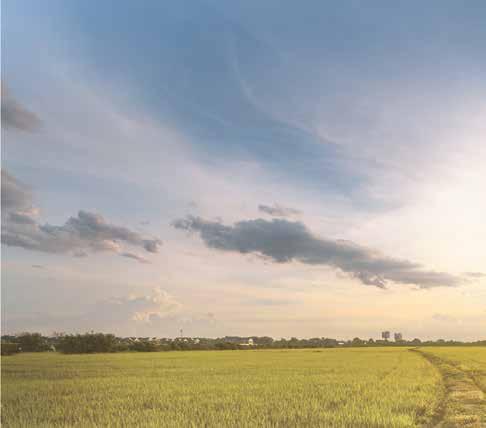








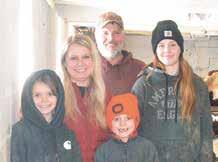

















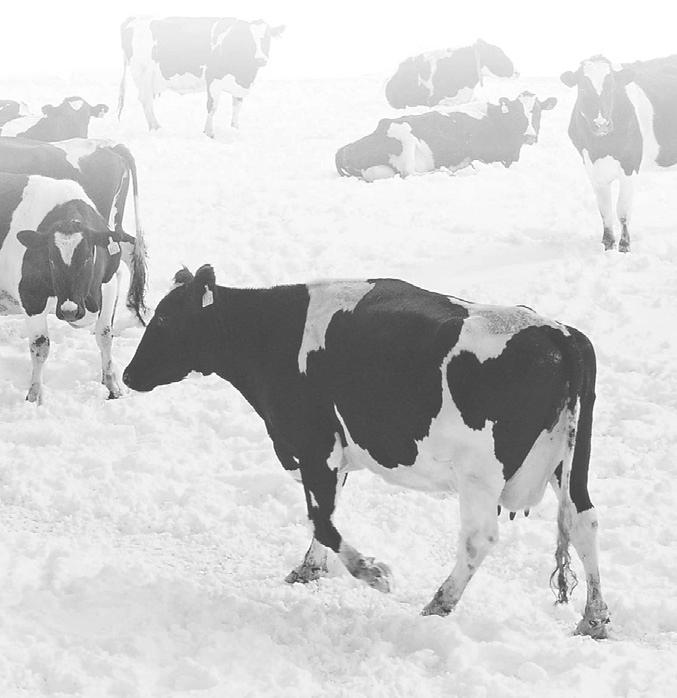














farm’s operating loan. EWG said the Price Loss Coverage program paid out the most money to lenders, accounting for 6% of farm subsidies from 2019 to 2021. The Farm Service Agency received the most payments in 2021 at $87 million. AgriFund, which does business as Ag Resource Management, received nearly $35 million. AgCountry Farm Credit Services is ranked third at $18 million.
EWG database described as ‘misleading’
The Environmental Working Group’s so-called Farm Subsidy Database has been highlighting farm program payments since 1995. Rather than releasing the names of all farmers receiving payments, USDA now lists the lender. AgCountry Farm Credit Services President and CEO Marc Knisely said the EWG information is misleading. “The only time a lender is listed as having received this support payment is when the farmer actually makes an assignment to a lender,” Knisely said. “This money does not come to the lender for the lender’s benet. It is provided on behalf of the farmers and ranchers as a payment to be applied to their loan.” Knisely also takes issue with the EWG characterizing farm program payments as a subsidy. “It is just unfortunate; causing a rift by using terminology like that is disappointing,” he said.
Suputo announces cheese plant decisions
Suputo is investing $180 million in a Franklin, Wisconsin, cutand-wrap cheese facility. This site is expected to be operational by 2025. The Canadian dairy processor is also closing three facilities to streamline its operations. That includes a South Dakota plant that will close in 2024 and a Green Bay, Wisconsin, plant that will shut down in 2025. Suputo is also converting a cut-and-wrap cheese facility in Tulare, California, into a string cheese plant. The South Gate, California, string cheese operations will close in 2025.
National recognition at specialty food show


Dairy Farmers of Wisconsin won the Specialty Food Association’s booth contest during the Winter Fancy Food Show in Las Vegas, Nevada. The Dairy Farmers of Wisconsin highlighted 16 types of cheese. More than 1,100 exhibitors were featured in the trade show.
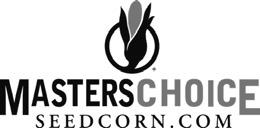
BLBW grants available






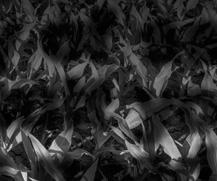








The Wisconsin Department of Agriculture, Trade and Consumer Protection is accepting applications for its Buy Local, Buy Wisconsin grants until March 31. Up to $200,000 in competitive grants will be awarded this year. The grants are designed to provide consumers with more Wisconsingrown food products.



IDFA names chief economist
Mike Brown is the new chief economist for the International Dairy Foods Association. Previously, Brown was the director of the dairy supply chain for the Kroger supermarket chain.
Peterson to Consult for IDFA
The International Dairy Foods Association has added three dairy policy consultants. The trio includes former House Agriculture Committee Chairman Collin Peterson, who now leads The Peterson Group. In addition, Chip English of the Davis Wright Tremaine LLP law rm and Steven Rosenbaum of the Covington law rm have signed on with IDFA. Both have experience with federal milk marketing orders.

Daniels now leads Dairy Innovation Hub Advisory Council






The Dairy Innovation Hub Advisory Council has elected Dave Daniels of Union Grove, Wisconsin, as its chair. Daniels succeeds Mitch Breunig of Sauk City, Wisconsin. The Dairy Innovation Hub is a $7.8 million per year investment by the state to keep the Wisconsin dairy industry at the global forefront.
2023 OYF winner named Travis and Melissa Marti are the 2023 Wisconsin Outstanding Young Farmers. The Marti family has a dairy operation near Vesper, Wisconsin.
Trivia challenge
Poutine is a classic Canadian dish featuring fries, cheese curds and gravy. That answers our last trivia question. For this week’s trivia, what year did John Deere start producing and selling lawn and garden tractors? We will have the answer in the next edition of Dairy Star.
Don Wick is owner/broadcaster for the Red River Farm Network, based in Grand Forks, North Dakota. Wick has been recognized as the National Farm Broadcaster of the Year and served as president of the National Association of Farm Broadcasting. Don and his wife, Kolleen, have two adult sons, Tony and Sam, and ve grandchildren, Aiden, Piper, Adrienne, Aurora and Sterling.
the most demanding hydraulic attachments. When you need to attack your toughest jobs with pure Bobcat performance, the M2-Series 700 and 800 platform loaders deliver. This rugged lineup delivers the size, machine weight, lift capacities and horsepower to do more, while maintaining the exibility and versatility of a compact machine.

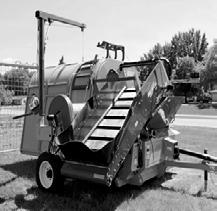
Con nued from MARTIS | Page 1 a farm, but I wanted for our kids the things they could learn from growing up on the farm.”
with a somatic cell count of 120,000.
The Martis farm 1,200 acres, 700 of which are owned. They raise alfalfa and corn that is harvested as silage, high-moisture and dry. They also raise soybeans that are sold or traded for protein meal and sorghum for dry cow feed. The farm has seven fulltime employees working in the dairy and another full-time employee working in the shop and operating equipment. Travis’ father helps seasonally with eldwork, and the Martis also employ additional part-time seasonal help with eldwork.
Travis has embraced the idea of incorporating conservation farming methods. Approximately 50% of the Martis’ acreage has been no-tilled for the past two years, and cover crops are utilized on about 50% of the ground as well.
“It has been a learning process,” Travis said. “You just have to experiment and nd the system that works for you. Sometimes it is a little scary because there is really no right way to do it, but I like what I am seeing. The less tillage we do, the better our seed beds look.”
The Martis said one of their goals is to build a business that is sustainable for the next generation should any of their children decide that is the path they choose to follow.

“I grew up working on my parents’ dairy farm, but I wanted to become an engineer,” Travis said. “I did not plan to come back to farm, and my dad didn’t have that expectation of me. I went to Michigan Tech where I got my degree in mechanical engineering. It was during my junior year that I started to think that I was missing farming.”
While at college, Travis and Melissa met. Following graduation, they were married and each continued to pursue their intended career paths: Travis worked for Ford Motor Company, and Melissa took a teaching job. Soon after, Travis began thinking the corporate world was not the place he dreamed of being.
“It was meeting after meeting after meeting and being indoors all day,” Travis said. “I began to feel the draw to farming more strongly.”
The young couple decided the farm was the place they wanted to make their lives and raise their family. For Melissa, who did not grow up on the farm, it was a leap of faith.
“We knew we didn’t want to raise our family in the city,” Melissa said. “I grew up in the country but not on
In 2007, the Martis returned to the farm which was home to 120 cows. The cows were milked in the farm’s stanchion barn and housed in a freestall barn built in 1992.


While he had grown up helping his parents on the dairy farm, Travis said the rst year was spent learning the ins and outs of the business.
“I hadn’t studied dairy or soil science or anything,” Travis said. “I had to learn the cow side and crop side of the farm. I spent a lot of time attending PDPW and extension events to learn as much as I could.”
In 2010, the Martis took the rst step toward taking over the family farm by purchasing the cows and taking over management of the herd from Travis’ father. They increased the herd size to 160 cows. The purchase of equipment followed in 2012.



“We were fortunate to be in a position that we were able to transition over time,” Travis said. “We were able to do it in small pieces that we could afford, and it provided a steady cash ow for my parents as they transitioned out. I don’t know that we could have done it any other way. It is such a capital-intensive undertaking.”
By 2013, the Martis realized they had no room to grow in their current facility. They began planning a building project.

“We really wanted to focus on cow comfort,” Travis said. “We had purchased a wonderful herd of cows from my parents, and we wanted to take the best care of them we could.”
In 2015, the Martis began building their current facility with an eye toward efciency in addition to cow comfort. When the facility was complete, the herd doubled to 300 head through the purchase of animals from three different herds. The remainder of the expansion, to the current 500 cows, took place through internal growth.

As their farm has grown, the Martis have become passionate about sharing their story, and Melissa utilizes a Facebook page to help educate consumers and build a relationship with those in their community.
“It was intimidating to start, not knowing what to expect, but the feedback has been great, mostly very positive,” Melissa said. “If we don’t tell people what we are doing, someone else will whether it is factual or not.”
that’s where we wanted to inject our product.”
The dairies received a down payment after signing letters of intent with Novilla RNG. The dairy operators will receive a second payment when construction of the digesters reaches approximately the six-month mark and another payment when the digesters are completed. Participating dairy farmers will receive their rst royalties a year after gas production begins.
“The majority of the revenue for this project comes from being able to sell negative carbon intensity gas to end customers,” Williams said. “A CI score is a measure of how much greenhouse gas emissions are released to create a unit of energy. As a reference, the CI of gasoline is +92, geological natural gas +67, solar and wind, near zero. The gas being generated at these dairies is expected to have a CI score in the negative 200s. This is an energy equivalent to roughly 1,025,000 gallons of gasoline per year.”
Adam Fedders is the assistant utilities manager for the city of Sioux Center, a growing town with a population of 8,583.

“During the summertime, the dairies will be capable of suppling 100% of Sioux Center’s natural gas needs,” Fedders said. “There hasn’t
been any pushback against this project. People are happy to have a local, dependable source of renewable energy. It benets our local economy and increases Sioux Center’s natural gas capacity.”
Sioux Center’s utilities department will break ground this spring on a 6-inch natural gas pipeline that will run from Sioux Center to Hoogland Dairy. It is hoped that the pipeline project will be completed by this fall. The estimated $5.2 million cost for constructing the 8-mile pipeline will be covered by Novilla RNG.
“During the wintertime, the dairies will supply only a portion of the natural gas used by the people of Sioux Center,” Fedders said. “This is not only due to higher demand during the colder months, but also because the dairies will need to burn more of their gas to heat the digesters.”
Maassen said there will be three or four West Branch employees on-site at all times to manage the digesters and the renery.
“Our only job is to send fresh manure to the digesters every day,” Maassen said. “They want the manure to be as fresh as possible to increase methane yields and to decrease the amount of gas that will need to be burned to maintain optimal operating temperatures in the digest-
42,652 CFM 18.4 CFM/Watt @ 0.10” SP
Brian
ers.”

The nutrient value and the volume of the digested manure will remain unchanged.



“The only difference is that the nutrients in the manure solids may be more available because they have been predigested,” Maassen said.
The amount of revenue the dairies will receive for their renewable natural gas will vary according to market conditions and the quantity of methane produced.
“We have entered into a






20-year contract with Novilla RNG, so it’s a long-term relationship,” Maassen said.
“The digesters have been sized to allow for the future growth of our dairy herds. At peak capacity, the two digesters will be able to handle the manure from a total of 8,000 cows.”
Maassen Dairy beds their free stalls with sand. Preventing waste sand from entering the manure stream will create some managerial and technical challenges.
“Keeping sand out of the
digesters is a big concern,” Maassen said. “We will be installing additional equipment, such as slope screens, to help us recover 100% of our waste sand. This will result in cost savings for us and better bedding for our cows.”
Brian Roorda is looking forward to the project.
“This project is good for us, good for the local community and good for the environment,” he said. “It became very exciting once I learned that the town of Sioux Center is going to be involved.”

Maassen agreed.
“Our focus is caring for our cows and our land,” Maassen said. “We are in the business of producing milk, not renewable natural gas. We were looking to partner with someone who knows the renewable natural gas business, and Novilla was a good t.”
Roorda said the digesters will help the three dairies remain protable well into the future.

“It just feels good to do something good,” he said.
Maassen said the amount of carbon-neutral energy the dairies will produce will be the equivalent of taking 8,800 cars off the road.
“The digesters will simply be capturing the gas that is naturally produced by the manure,” he said. “The development of new technology has now made that economically feasible.”
SPARTA, Wis. – At the age of 16, Randy Brueggen quit school to run his family’s farm.
“I’ve been at this my whole life I guess,” Brueggen said. “We lost my dad in 1982 when I was 16, and I decided to farm. I gave up school and stayed home with Ma.”
After more than 40 years of farming, with soil conservation in mind, the Brueggens are being honored for their efforts with the Monroe County Conservation Farmer of the Year award.

Brueggen owns Brueggen Family Dairy Farm Inc. with his mother, Betty Brueggen. They milk 550 cows and farm more than 1,000 acres of owned and rented land near Norwalk. Randy’s brother, Tim Brueggen, and their nephew, Chad Herricks, are both involved in the daily management of the farm along with their employees.
For nearly half a century, the Brueggens have imple-
mented various conservation farming methods to keep the soil healthy and avoid runoff. They were presented the farmer of the year award Jan. 28 at the 47th annual Land Stewardship Awards banquet in Sparta.
Brueggen credits Jack Herricks with being instrumental in helping to put the farm’s conservation plans into action. Randy began working for Herricks when he was just 14 years old. When Brueggen’s dad died, he leaned on Herricks for wisdom in helping his mother run the family farm.
“That’s 40-plus years we’ve been working together,” Brueggen said. “All the cropping is done together, and things just go real smooth.”
The two have been combining their time, equipment and knowledge to get both farms’ crops planted and harvested since 1989.
Brueggen said there are many small steps that have
led to the benets they have seen over the years.
“Mom always made the comment that it’s not about one big thing you do,” Brueggen said. “It’s every little thing you do that paints the big picture of it all.”
Their conservation efforts began in 1996 with the manure pit that was built as part of a herd expansion.
“We can apply the manure at an even rate, and we know what we’re putting out there,” Brueggen said.
When the manure pit was built, a feed pad was also added to the farm. This features a leach system where any runoff of rainwater, snow melt or uid from the silage pile drains into the manure pit.
Contour strips have been implemented as well to help avoid soil erosion. Along with that, corn is planted in 20-inch rows as opposed to the typical 30-inch rows. Brueggen said the narrow rows gain a higher yield of silage harvest than wider rows. While the grain harvest from narrow rows is not a signicant difference, it does aid in preventing erosion, he said.
Their conservation practices do not stop there.
With low equipment, operational and maintenance costs, Air King industrial air cleaners are an economical way to improve your overall air quality.


APPLICATIONS:
•Welding smoke/fumes
•Grinding dust •Bondo dust
•Oil mist •Diesel fumes
•Printing powder •Plastic dust
Air King industrial air cleaners are a valuable tool for capturing most airborne nuisance particulate. Our self-contained filtration units continuously pull contaminated air through multiple stages of highly efficient micro-glass filters. The filtered air is then re-circulated back into the working environment without the need for duct work. This results in a cleaner, healthier atmosphere for employees, while saving you money by keeping heated or air-conditioned air inside your facility.
•Other smoke/dust contaminants
1-800-669-4038 www.carlsonwholesale.net
Ritchie manufactures a complete line of livestock watering products with the highest specifications in the industry. From a single horse Stall Fount to a fountain that waters up to 500 head, Ritchie fountains are top quality. Plus, every Ritchie fountain is backed by our 10 year limited warranty. For more information contact us at:


Carlson Wholesale - 800-669-4038



www.carlsonwholesale.net
@carlsonwholesale
In the fall, corn stalks are not harvested for bedding; rather, they are left on the eld and tilled in the fall so they atten out. This helps to keep the ground covered and allows the shreds to break down easier in the spring. The shreds are tilled just deep enough to break down the stalks but not break into the ground. This is necessary with the narrow rows and to keep from disturbing the soil, Brueggen said.
Winter rye is grown for a cover crop. The seed is broadcast and then manure is hauled right away in fall which Brueggen said helps the seed to
germinate. In spring, the crop is killed off with manure, rather than harvested for feed, which adds to the soil health.




“It’s important to keep the ground covered so you’ve got the least amount of exposure to runoff and to try to keep from washing soil away,” Brueggen said. “When you kill rye out, it puts nitrogen back into the ground. They call it the green fertilizer.”
There is also the benet of the rye growing in the spring when the snow melt causes runoff.
No-till planting has also had an impact on the health of the farm’s soil, Brueggen said.

“It reminds me somewhat of potting soil,” he said. “We’ve got a lot of clay in our area, and back when we would moldboard plow, there’d be knobs that if you plowed at night it was like Fourth of July because there’d be sparks ying off of plow shears.”
The organic matter has built up over the years with consistent manure applications, planting cover crops and leaving the shred residue. It has all added up to healthier soil and more resilient crops.
ter for the plant to keep growing when it dries out.”
Another benet to not plowing is that the need to pick rocks has signi-


cantly decreased. While there are still some rocks that get kicked up from seeding, Brueggen said it is nothing like it used to be.
Randy
accepts the award for 2022 Monroe County Conserva on Farmer of the Year from Wisconsin Rep. Loren Oldenburg Jan. 28 at the Land
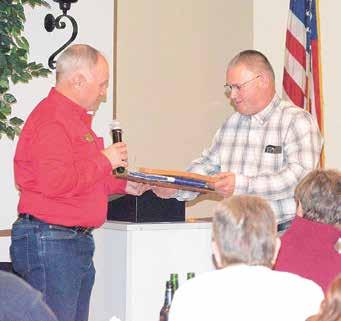
in
“I think our crops are more drought tolerant today,” Brueggen said. “I think that’s just because the ground can hold that moisture bet-

“I think our crops are more drought tolerant today. I think that’s just because the ground can hold that moisture better for the plant to keep growing when it dries out.
RANDY BRUEGGEN, DAIRY FARMER
BUILT TO KEEP GOING.
BECAUSE A FARM NEVER SLEEPS.
‘15 JCB 536-60 Telehandler, CAH, 3,200 hrs
IH 574 Diesel tractor, 2050 loader, 3,100 hrs.
‘12 Kinze 3000, 6RN, coulters, 2,200 acres
‘92 Kinze 2000, 7R19”, air planter
‘09 Kinze 3200, 12R30, LF
JD 7200 Conservation, 6R30 Dry
Tonutti 12 wheel Dominator rake
‘20 Vermeer VR1022 wheel rake
H&S 12 wheel rake
Gehl 420 10 wheel rake

‘15 Pottinger 762C rake
‘12 NH H7450 13’ discbine
MF TD1620, 2 rotor tedder
‘12 NH H7450 13’ discbine

NH 1499 SP haybine, 12’, CAH
‘94 Hesston 8200, 12’ head
‘22 Kinze 3505, 15R15, bulk fill, 1,400 acres
Sunflower 4211-9, disc chisel w/ buster bar
IH 6000 Consertill, 13 shank
DMI 530B Disc Ripper
JD 712 9 shank disc chisel
CIH MRX690, 5 shank disc ripper disc.
PEOPLE MOVING PRODUCT
Cheese as a love language
Noble Rind Cheese Company offers a unique buying experienceBy Abby Wiedmeyer abby.w@dairystar.com
– The rst time Sarah Clemens tasted artisanal cheese, she knew she could never go back to eating mild cheddar. When she began working in a specialty food shop in her early 20s and discovered the connection between local cheeses and the farms they came from, her perspective changed and an appreciation for quality cheese and dairy farming was formed.
“I’m not really sure what about it (dairy farming) pulled at my heart so much,” Clemens said. “But once I made the connection of where our dairy products come from, I was just fascinated by it.”
The St. Paul, Minnesota, native has made a home in Wisconsin’s Driftless Area as a cheesemonger. Her cheese shop, Noble Rind Cheese Company, celebrates its oneyear anniversary in February.

The cheese case takes center stage at Noble Rind Cheese Company, with a large variety of cut-to-order cheese options. There is everything from local raw milk cheese to elite cheeses imported from Europe. In between, there are classic cheddar and havarti cheeses, among others.
with milk and butter in the recipe. All of the dairy products used in the kitchen are sourced from Organic Valley, Westby Cooperative Creamery and Grassland Dairy.
While Clemens is not a licensed cheesemaker, she does make her own version of American cheese. The process involves shredding Organic Valley cheese and mixing it with butter, milk and a couple other ingredients. The mixture is then blended to create a creamy, melty texture. It is portioned out and used on sandwiches.
cheesecake.
While there is always a rotation of varieties of cheese, Clemens said that Widmer’s Cheese Cellars brick cheese, Pleasant Ridge Reserve and havarti are among the top sellers.
Vermeer 840, 10’3” disc mow. cond.
Gehl 2450, 15’ hydro swing disc mower
Haybuster 2650 bale grinder
‘22 JD 350C Center Pivot Mower, ONLY 300 ACRES! SKID LOADERS
JD 980 Field Cult., 44’ w/harrow

CIH 4800 30’ Field Cult, w/3 bar coil tine harrow
‘12 Brent 782, grain cart tarp scale, nice JD 7200, vac, 6 row, 30 dry Easy Trail 500 Grain Cart ‘06 NH BR780A, baler/wrap

‘04 Polaris 400 Sportsman
‘08 Agco 3000 Corn ‘21 Bobcat S76, 344 hrs. ‘19 Bobcat T595 ‘17 Bobcat T770, 1800 hrs. ‘18 Bobcat T770, 2400 hrs. ‘05 Bobcat T300, 4900 hrs. ‘19 Bobcat 3400 side-by-side, 4100 miles ‘19 Bobcat T595, SJC,CAH 1300 hrs.
Customers can taste cheeses before buying them. Once a selection is made, the order is hand cut from the wheel.
“I wanted to have the more interactive buying experience where people could taste cheeses before buying them,” Clemens said. “They could learn why one cheddar tastes so different than another cheddar, which
“You really have a personal connection to the product and the land where the product is coming from,” Clemens said. “I really love that.”
Along with the cheeses on hand, Noble Rind Cheese Company also offers a menu of soups and sandwiches where all the ingredients are made from scratch, including the bread. One popular bread is a white loaf
“Cooking is denitely my love language, and I have a real passion for cheese,” Clemens said. “I have been very fortunate that my passion and interests lined up with my work.”
Other dairy items used regularly in the kitchen include heavy cream, half-and-half, Westby Cooperative Creamery French onion dip and a local cream cheese that is used in the homemade
Clemens also uses her platform to educate customers about cheese. Some tips she offers include wrapping cheese in cheese paper instead of plastic, serving cheese at room temperature and that all rinds are edible except for wax or cloth rinds. Clemens offers demonstrations for how to build cheese or charcuterie boards as well.
Future plans for the shop include expanding the menu to include breakfast items.
Noble Rind Cheese Company is located within the larger Historic Fortney Hotel building with newly renovated boutique hotel rooms. Guests will be able to stay over-
night this spring.
Once that is up and running, hotel guests will be able to come downstairs to have a simple breakfast at Noble Rind Cheese Company.

“Though we’re not big enough to offer hash browns, eggs and a full farmer breakfast just yet, I’m excited to nd a good local yogurt to use in addition to offering pastries, fresh fruit, toast, and meat and cheese for breakfast,” Clemens said.
Clemens said she has seen the trend of dairy alternatives start to dwindle and believes it is a wave that will settle down. This is important to her because she values real dairy as a vital part of her business.
“I do think the trend will ease up especially as more and more education gets out there about how livestock and dairy operations are a vital part of our lifestyle and our environment,” Clemens said.
Clemens plans to promote dairy through her shop and her support of local cheese producers. She continues to be enamored with the romance of dairy farming and the quality cheese that comes from it.


“I think what fascinates me, too, is that milking animals is one of the most ancient traditions that we have in our civilization,” Clemens said. “That’s just really compelling to me. This is our survival, and this is life.”
What counties or area do you cover? I work for Wabasha and Olmsted counties, plus I test a few herds for the state. With a herd in LeRoy, Minnesota and 30 minutes north of Menomonie, Wisconsin, I get to see a lot of eastern Minnesota and western Wisconsin.
Don Heise









17 years with DHIA

What do you enjoy about the farmers you work with? Some of the farmers I deal with have become very good friends. There have been invitations to baptisms, graduations, weddings and, unfortunately, a few funerals.

What do you like about your work for DHIA? DHIA has given me the exibility to set my own schedule; If one of the grandkids has a ball game, I can usually schedule my day so I can go. DHIA, as an organization, has put together a great team for support. Support is just a phone call away.

What do you do in your free time? We have 30 beef cows. My wife raises a rare breed of horses (8) called Nokotas. 3 Border Collies, and the best hobby ever, 15 grandkids!

“Some
 By Amy Kyllo amy.k@star-pub.com
By Amy Kyllo amy.k@star-pub.com
WAUKON, Iowa – When Fritz Bushman and Alyssa (Nessa) Bushman locked their siblings Zack and Rachael in the mudroom together until they decided on a rst date, they sealed their fate of two brothers marrying two sisters.




Fritz and Alyssa Bushman and Zack and Rachael Bushman are organic dairy farmers in northeast Iowa. Fritz farms with his parents and another brother on their 160-cow dairy where they milk twice a day near Castalia. They also farm 700 acres and raise 14,000 laying hens.

Zack and Rachael’s organic farm is located near Waukon, about half an hour away from the family’s home farm. They have 120 cows, 400 acres and milk three times a day.

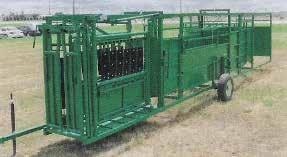
The two farms collaborate together for eldwork.



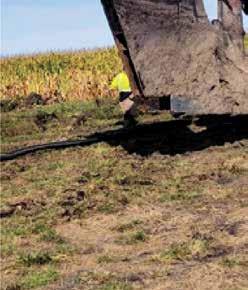



The Bushman brothers met the Nessa sisters through church when the Nessas’ dad came to be the pastor where the Bushmans attended. Fritz and Alyssa were the rst two to fall in love.

The farm played a part in their love story.

“Our dating life revolved around milking and eldwork,” Fritz said.

Though unconventional, Alyssa said it did the trick.
“Our rst date was plowing together,” she said.






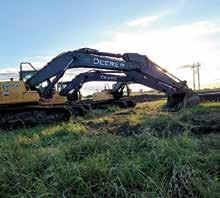


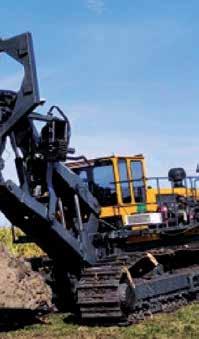


Fritz even let her drive the tractor, and Alyssa became confused in the dark and accidentally took a few tines off of a rake that was sitting at

the end of the row. They were married less than a year later in 2013.
Zack took a little more prodding to get a relationship going with Rachael.
Rachael was home from college for Thanksgiving break in 2014. Zack said he had a crush on Rachael since
he was 12, and the timing was right.
“I knew that he was going to ask me out that day,” Rachel said. “So, I followed him around kind of like a puppy dog. … He never asked me out. He had all these opportunities.”
Thankfully, their already married respective siblings came to their rescue. When Rachael’s parents got ready to leave on Thanksgiving from the Bushmans’ house, Fritz and Alyssa offered to take Rachael home. They got both Zack and Rachael inside the mudroom, and Fritz guarded the outside door while Alyssa guarded the inside door.
“We thought, ‘They’re in there. They have no choice,’” Alyssa said.
The ploy worked. A year and a half later, they too were married.
Though they married brothers, the sisters have very different personalities and joke they married each other in male form. Rachael said their husbands each have a personality that seems to correspond to their respective sister-in-law.


“I’m similar to Fritz, and Alyssa is similar to Zack,” Rachael said.





All four of the Bushmans are involved on their respective farms.





Fritz and Zack farm full time. Fritz does morning milking and works with the calves. He also is the mechanic of the family since he completed the John Deere training program at Northeast Iowa Community College in Calmar.



Alyssa is a stay-at-home mom. She takes care of their four children: Cyrus, Dulcy, Estelle and Gracia. She also helps with eldwork when they need an extra hand.
Rachael is also a stay-at-home mom for their four children: Sophia, Briella, Joanna and Elliana. Rachael helps with the bookwork, taxes and payroll for the farm. In the barn, she helps with one of their three milkings and also helps with calf feeding. Zack and Rachael have a full-time employee and one part-time high school student who helps. Zack takes care of everything else. He also does custom merging and manure hauling.
The Nessa sisters, who did not grow up on a farm, have found that raising their children with this lifestyle has provided its own unique experience.
“They learn a lot of responsibility,” Rachael said.
Alyssa and her children have had a different experience living in town. Alyssa said living in town is the best of both worlds and the worst of both worlds. The opportunities to do things like walk to the library in town are offset by the reality that Fritz cannot stop by for breakfast or lunch, and the kids do not get to go off with him in the tractor on a whim.
Alyssa and Rachael have broadened their understanding of dairy farming since their marriages.

“I didn’t know that farmers never stopped working,” Rachael said.
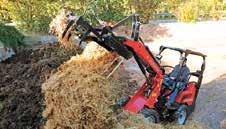
Alyssa said she realizes now that some of her early conceptions of farming were incorrect.
“I didn’t realize how much technology has gone into farming,” Alyssa said.
Both couples have hopes and goals for their farming operations. Fritz and Alyssa hope to buy into the family farm and also build a house on the property. Zack has dreams of expanding the freestall barn. His current freestall capacity is 130 stalls spread throughout three buildings. He hopes to increase that to 150 stalls or more.
Both couples have marriage advice for other farming couples.



“When working cows, don’t take things seriously,” Fritz said.

Zack said couples should milk cows together at least once a day, and Alyssa encourages couples to go to bed together. Rachael said it is important to work to understand each other and the issues that each may be experiencing.

“When working cows, don’t take things seriously.”
FRITZ BUSHMAN, DAIRY FARMER


















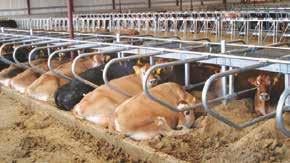

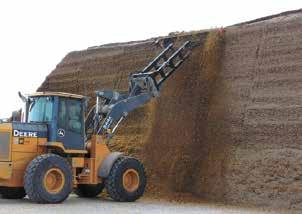


























(pictured with his wife, Barb Schank) Arcadia, Wisconsin Trempealeau County
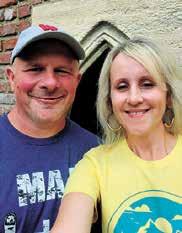
600 cows

What is your favorite winter hobby? Attending kids’ sports activities. My daughter is in basketball, and my sons were in wrestling before they graduated.
How did you get introduced to this activity? We have four kids and did a lot of running around with kids for a long time. Now, my fourth one is graduating, and we’ll start again with grandkids in a few years.
How do you balance farm work and your hobby?

I am in a partnership with my brother, and he’s now at the point where his kids are getting involved so we make sure one of us is at the farm when the other one needs to be gone. My oldest son, Nick, also farms with us, and he makes sure to be here too.
What is the value of you having an activity away from the farm? It gives us a break. More than anything, it's a mental break where you can think about something other than your normal day-to-day stress and activity. It gives you something else to think about and to talk about when you talk with other people.
Tell us your best story associated with this hobby. Through the years, there’s not one that sticks out, but I’ve been to some games and matches where it ended up being exciting. It ended up that I was glad I went, whether it was an unexpected win or a close match.

What else occupies your spare time during the winter? Plowing snow and thawing water pipes, and there is more work with cattle because there’s no pasture which means no more bedding and manure to haul. I’m glad we don’t have any silos anymore. Being a dairy farmer, you’re always busy, but you’ve always got a different task for each time of year. We also have to make wood to keep the wood boiler going.
Tell us about your farm. We milk 600 cows and farm 1,500 rented and owned acres. We plant corn, soybeans and alfalfa. We do quite a bit of cover crops as well. Our milk is shipped to Grassland Dairy. My brother, Jason, and I are in a partnership, and my oldest son, Nick, is employed by us. My father, David, still owns some land and works part time for us. We have a good crew of employees as well.
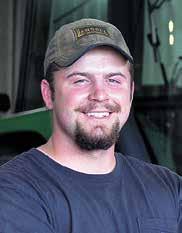

Luke Sprecher Sauk City, Wisconsin Sauk County
170 cows

What is your favorite winter hobby? My brother and I meet up with a couple friends and go for a loop on our snowmobiles. We usually stay within our county.
How did you get introduced to this activity? We snowmobiled with my dad when I was a kid so we bought our own over time. My dad still comes with us sometimes.
How do you balance farm work and your hobby? We don’t go out until we’re all done for the day. If we’re too busy, we don’t go out. If we have a couple hours to spare before night chores, we’ll go out for a loop; otherwise, we usually go after night chores.
What is the value of you having an activity away from the farm? It gets your mind off the farm to go out and visit with people. A lot of the places we stop are bars to warm up in, and we see other people there. It’s nice to catch up with others who are doing the same thing.
Tell us your best story associated with this hobby. Back in December, my brother, neighbor and I were going to do the Sauk County loop. It had just snowed and was going to be really cold right when the trails were open and hadn’t been gone through. We haven’t done the Sauk County loop in a couple years. We got an hour into it and realized we were lost. It was 25 degrees below zero, and the snow was blowing so hard it was difcult to see. After ve hours without stopping, we realized we were in Loganville. Then, we knew where we were.
What else occupies your spare time during the winter? Doing shop work and modifying equipment for the next crop season. I enjoy tinkering in the shop in the winter.
Tell us about your farm. I work full time for Enge Homestead. My brother works here, too, along with their other employees. We farm about 700 acres. We have 170 cows and all of our youngstock. We grow hay, corn, soybeans and wheat. Also, my brother and I have our own farm at home with our dad and our other brother. We all work off our home farm and have 70 steers and about 100 acres of mainly corn.
Terry Popp Rice, Minnesota Benton County 200 cowsWhat is your favorite winter hobby? I like to go coyote hunting in the winter. I go out at my place at night with a call after chores are all done. It’s best to go when there is a full moon. There is a neighbor kid that comes with me sometimes too.

How did you get introduced to this activity? I always wanted to catch one because they can be so elusive, and they don’t make much noise. I was into trapshooting as a kid, and it evolved into this. I have been actively coyote hunting for about 10 years now.
How do you balance farm work and your hobby? Because I hunt coyote at night, it is easy to balance with dairy farming. As soon as I get evening chores done, I get all my white hunting gear on and go out. The next day, I am a little tired, but it’s worth it.
What is the value of you having an activity away from the farm? It refreshes you. Just being out there gives you time for your mind to reset. When there is a full moon and everything is just so calm and still and peaceful; it’s a really cool feeling. It always amazes me how these animals can survive out there on these 20-below nights.
Tell us your best story associated with this hobby. One night, when I was walking out to go hunting, a big white owl came up and started hovering right above my head. I got kind of scared that he was going to attack me. I shooed him away, and thankfully, he ew away. There was another time a bald eagle came down and swooped at my electric call.
What else occupies your spare time during the winter? I also enjoy reloading bullets. I buy my own powder, primer and the empty bullet cases. I have been doing that for 15 years. It’s getting harder to nd the powder, so I might not get to do that one as much in the future.
Tell us about your farm. We farm 460 acres of corn and alfalfa. I farm with my brother, Russ, and together, we milk 200 cows in a New Zealand style swing parlor. We even had a guy from New Zealand come here and install it. My wife, Julie, and kids, Ingrid, Greta and Sam, help as needed. We have one full-time employee. We ship our milk to First District Association in Litcheld, Minnesota.
Star Blends has been helping Midwest farm families by providing, high-quality feed, dairy nutrition, and commodity contracting for more than 20 years. Our state of the art mill can accuratelyblend anything from a custom pre-mix to complete feed,

in balancing diets, or work with your private nutritionist or dairy consultant.
Contact Star Blends at: 800-462-4125 or StarBlends.com




180 cows
What is your favorite winter hobby? Snowmobiling. I enjoy the scenery and the different views I see while I’m out there, like pine and cedar trees covered in snow and wildlife such as deer. The things you get to see while being on a sled are pretty cool, and it’s also fun to see the other sleds that are out on the trails.
How did you get introduced to this activity? I have farmed here all my life with my dad, and as a kid, my best friend had a snowmobile. I rode with him on the eld sometimes but not on any trails. I hated working in the cold and thought, “Why would I want to play in it?” But in 2007, my brother and sister-in-law left a snowmobile in the shed when they moved out and asked me if I would show it to prospective buyers. I asked them how much it was. When they said $500, I said I’d buy it. I started out messing around in the elds and thought it wasn’t so bad. When a friend took me out on the trails for the rst time, I was hooked. Then, my thoughts shifted to if I have to work in the cold, why not play in it too? My snowmobiling hobby escalated from there, and I bought a brand-new snowmobile two or three years later.
How do you balance farm work and your hobby? I do the work during the week and snowmobile on the weekend. My best friend has property near Antigo, Wisconsin, and I’ve gone up there four weekends with him since the trails opened up this season. I get extra jobs done during the week, and my family takes care of the basics on the weekends. When trails open up here, I usually hop on and go for a ride after chores are done. On Feb. 2, I took my big annual trip to Grand Marais, Michigan. I’ve been doing that with friends for about seven years. On this ve-day trip, we average 400 to 600 miles on our snowmobiles.
Goodridge, Minnesota
Pennington County
175 cows
What is your favorite winter hobby? We have two winter hobbies, watching NASCAR and snowmobiling. It is funny how both involve motors and speed. One allows us to enjoy our cozy living room; the other the invigorating, beautiful Minnesota winters.
How did you get introduced to this activity? NASCAR grew slowly. We had a mild interest but started paying more attention and got hooked. We have followed it seriously for more than 20 years. Getting to races in person is rare, but we are excited to be attending the Daytona 500 Feb. 19. On the other hand, snowmobiling has been Mike’s passion since he was 13. He introduced me (Linda) to sleds when we met 35 years ago and have spent many days riding northwestern Minnesota trails between morning and evening milkings.
How do you balance farm work and your hobby? NASCAR is easy since we watch on TV and try to take Sunday afternoons off for viewing. In warm weather during busy times, we listen to the NASCAR radio channel. This year’s Daytona trip is possible because we have two sons farming with us and will leave with condence the cows are well cared for. Snowmobiling is usually a last-minute decision. We leave right from our front door, catch groomed trails within a mile and ride anywhere from 40 miles to 200 miles. We trade off riding opportunities, so someone is always home. Milking and feeding robots also allow exibility without rigid start times.
What is the value of you having an activity away from the farm? It’s my only source of rest. I don’t take time off otherwise with one exception. I bought a Corvette from my brother-in-law a year ago and have started going for car drives in the summer. Snowmobiling is the only time I’m gone overnight. It’s the only time I’m off for the whole year, and I don’t have to put on work shoes for a day or two. It’s my escape. I still do a lot of things for the farm before I go, and I maintain communication with everyone in case they need my help. I probably average 3,000 miles per year on my sled.
Tell us your best story associated with this hobby. About eight years ago, I invited a group of 30 neighbors and friends to go for a ride to get pizza. About 20 showed up. We left at 5 p.m. and rode to a pizza place. I remember stopping at a stop sign and looking back and seeing headlight after headlight coming through the woods. It was such an awesome sight. After we got done eating, there was a snowstorm, and you couldn’t see three sleds behind you, yet everyone had a safe, great night. Overall, I enjoy the camaraderie of snowmobiling – joking around with the guys and living in the moment. The sights and views are also why I like to do it and keep doing it. You meet a lot of people along the way, and that’s a great experience too.
What else occupies your spare time during the winter? Watching TV. I recently binge- watched the show, “Yellowstone,” and got hooked on it. I also deer hunt on my property.
Tell us about your farm. I bought the farm from my dad in 2000 and farm with my wife, Amy, our son, Mitchell, and our daughter, Rebekah. We also have another daughter, Amanda, who works off the farm. We also have two part-time employees, Justin and Abigail, who help with milking. If it wasn’t for all of these people doing such a great job, my snowmobile trips would not be possible. We milk three times a day in a swing-10 parlor. Our cows average 95 to 100 pounds of milk per day, and we ship our milk to Arla. Amy, Rebekah and Abigail milk the midnight shift; Mitchell, Rebekah, Justin and I milk the 8 a.m. shift; and Amy, Mitchell, Justin and Abigail milk the 3 p.m. shift. We farm about 450 acres of alfalfa, corn and wheat.
What is the value of you having an activity away from the farm? Mostly putting the day-to-day worries and stressors away for a while. Farming, particularly dairy farming, can be fairly isolating so getting out and about with others is uplifting and usually relaxing. We love what we do but nd refreshment in not having the farm and cows be the topic of conversation all the time.
Tell us your best story associated with this hobby. In 2004, we attended the spring NASCAR race in Las Vegas, Nevada. We were following a new young driver, Kasey Kahne, at the time and saw him run and nearly win a terric race. Fast forward to summer 2021. Kahne, after a successful NASCAR career, retired from Cup but still runs Sprint cars. A close friend of Mike’s, a shing guide, guided a party that included a promoter of Sprint car racing. Long story short, the conversation revealed this promoter knew Kahne personally, and we got free tickets and pit passes to races in Fargo, North Dakota, and a personal meet and greet with Kahne. Not a Cup race but lots of fun anyway.

What else occupies your spare time during the winter? There really isn’t much spare time, but we enjoy movies, old TV shows, a good book and other sports on TV. We are active in our church and the snowmobile club. We are busy with responsibilities as a soil and water conservation district supervisor and local cooperative board member.
Tell us about your farm. We farm 2,800 acres of cash crop soybeans, spring wheat and oats. We raise corn silage and alfalfa to feed the dairy herd. We are a Land O’Lakes producer, but the milk is hauled to Bongards in Perham. In 2016, we built a new facility with robotic milking and feeding systems to accommodate our three sons desiring to farm. Two are here with us and fully engaged in the farm, Matthew with the dairy and Steven handling crop duties. David farms with his in-laws in southern Minnesota but participates in decision making, exhibits the show cattle, works on the farm as able and markets our genetics with Matthew. David’s wife, Ashley, does our embryo transfer/in vitro fertilization work and straps the show cattle. Matthew’s wife, Malena, a teacher, helps if we are gone and readily lls in when needed. We have no hired labor.
• With more than 50 years’ experience.
• The Poultry Housekeeper removes feathers and caked or wet litter in less time than you ever dreamed possible.
• This simple one-man operation is the easy, cost-effective solution to litter management!
• House Keepers DB4s In-stock.
• Stainless steel feed box
• Heavy-duty drive
• Wheels mounted directly to wheel motors


• Main drive wheels, directly under feed weight, increases stability

• Chain Choices, #55, 62, or 662 pintle, or SS T-Rod
• Honda Engine powered (6 or 9 hp)
• 33, 43, 60, 73 bushel sizes available



















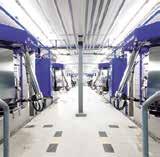






Towns Farms
Towns
Janesville, Wisconsin
540 cows total; 480 milking

Describe your facilities and list your breeding management team. Our milk cows are housed in a sand-bedded freestall barn and milked three times a day in a double-10 parallel parlor. We also have a special needs barn for close-up and early fresh cows that is located close to the parlor so these animals are easier to see and access. Dry cows are housed in our old tiestall barn which has been converted into free stalls. We raise heifer calves to 6 months of age. From 6 to 12 months old, they are sent to our neighbor who is a custom heifer raiser. They come home to be bred. We have a pack shed for heifers and a lane of headlocks outside. After they are conrmed pregnant, they are sent to a different neighbor and return home one to two months before calving. Our breeding management team consists of Marley Malkow from CentralStar Cooperative, our primary A.I. technician Alfonso Perdomo, our herdsman and relief breeder Dr. Haley Prohaska from Evansville Veterinary Service, and Mark and Pat Towns.
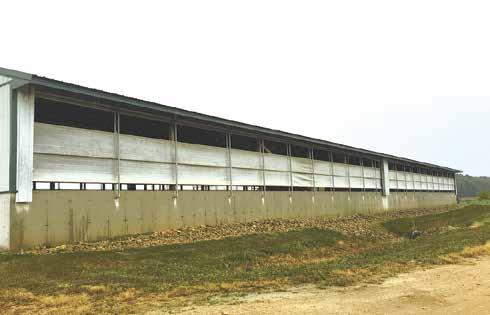
STACEY SMART/DAIRY STAR

Pat and Mark Towns own and operate Towns Farms near Janesville, Wisconsin, with Mark’s brother and sister-in-law, Sco and Nancy Towns. The Townses milk 480 cows.
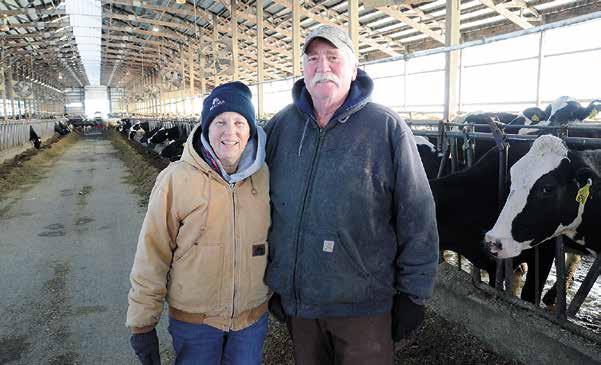
What is your current pregnancy rate? The pregnancy rate of heifers is 47% and the cows are at 27%.
What is your reproduction program? We use a double ovsynch program on all cows after a 70-day voluntary waiting period. We have it set up so that
if a cow shows heat on the rst Lutalyse shot after 70 days, we will cherry pick and breed off that. This is our highest repro code. If she’s in heat, it saves on shots. Before we give the second Lutalayse shot, we do have the vet, during a normal herd check, to check those cows for a corpus luteum. Typically, 10% to 15%
of cows don’t have a corpus luteum, so we will use a CIDR on those animals – about one to two cows per week. This is why double ovsynch is probably better than single ovsynch because hormones get where they need to be. We do not do an ovsynch program with our heifers. We may give Lutalyse sometimes
but almost all are bred off natural heats which we use tail chalking to help determine.
Describe your breeding philosophy. We don’t individually mate our cows. We use the computer system the bull studs offer to help stay away from inbreeding. We like a moderatesize cow that ts our facilities and produces milk that is high in protein and fat. We’re using young genomic bulls. Are they as good as proven bulls? Probably not. But with genetic progress, generations turn over faster. I like our 2-year-olds; they are milking well. They look like cows that are going to last. I think average is good versus breeding for extremes which can create problems. A 1,400- to 1,500-pound cow is a nice size for us. I think it’s more important to have a wide cow than a tall cow. I used to be happy to have cows that were immature. We didn’t expect as much out of them as 2-year-olds; we just wanted them to milk well as they got older. We don’t have that luxury anymore. They have to come out of the chute milking.

“We have been using Udder ComfortTM a long time. Today, we use the Udder Comfort Battery-Operated Backpack Sprayer to apply it quickly and easily on all animals in our fresh groups daily,” says Britney Hill (above), herd manager and part of the next generation operating Four Hills Dairy, Bristol, Vermont.
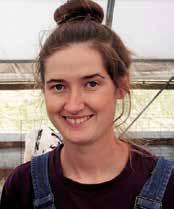
They milk 2300 cows, calving 10 animals a day, applying Udder Comfort to fresh groups daily for a 5-day course. They also love Udder Comfort for their award-winning show cows.




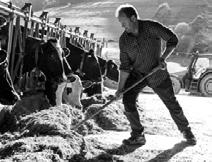








“With the Udder Comfort Battery-Operated Sprayer, we can do all in our fresh groups without slowing our parlor throughput,” Britney reports.



“It’s convenient, efficient, easy to maneuver, and the battery charge lasts,” she says.

















“With Udder Comfort, our fresh cows are more comfortable, and our fresh heifers adjust to milking much faster with better letdown. Doing all in our fresh groups helps keep our SCC around 130,000,” Britney explains.

What guidelines do you follow to reach the goals for your breeding program? Every time the new proofs come out, which happens three times a year, we change the group of genomic bulls we are using. That’s our safeguard in case we get a bull that is not that good. We stick within a certain price range and use bulls in the 80th percentile –not the highest bulls of the breed. We shoot for the best value. We use higher-priced genomic bulls on our heifers because heifers have better conception rates.
What are the top traits you look for in breeding your dairy herd and how has this changed since you started farming? It’s crazy how things have changed.

When I was in 4-H and showing cattle in the 1960s and ‘70s, we were all about pretty cows. We wanted milk too, but cows had to be so big. We went far away from that philosophy. If you’re making a living producing milk, you need to do it efciently. I think feet and legs are equally important to udders. I don’t like bad-uddered cows, but if we can get them through the parlor, we can milk them. If a cow has bad feet and legs and can’t get there, then we can’t milk her. I also breed for width so cows can gain capacity without getting so tall. If cows are not wide, they don’t have enough strength and don’t have as good of circulation. We also place emphasis on components. We are over 7% on combined fat and protein and use that as a metric to judge ourselves. Our cows average 91 pounds of milk, 4.4% butterfat and 3.3% protein. We used to average 100 pounds of milk but
Marley Malkow,





What is the greatest lesson you have learned through your breeding program? You can have the best of intentions genetically, but if a cow doesn’t settle, what good is that? We believe it’s best to start with conception. We used to struggle with conception. Days in milk would get long, and then you don’t get replacements. We had a young herd we were trying to grow, and if reproduction isn’t good, then it’s a battle.
What is the age of your heifers at rst service? 14 months.

herd. Our ideal cow is moderately sized with adequate depth and width, giving her the capacity to eat. We also like cows that get pregnant on the rst service and are aggressive eaters. They have to be in order to be a good cow. A cow with high components is another important quality we strive for.
25% sexed and 10%-15% beef.
Farms near Janesville, Wisconsin. Heifers are bred off natural heats star�ng at 14 months. had lower components. Our nancial consultant told us to focus on components. There was a change in emphasis from pretty type to functional type. We used to give registered cows a pass because they’re pretty, but we can’t afford that anymore. We used to try to get bulls into stud also. We had several that made it, with Townson Lindy being our most famous bull. Our No. 1 emphasis is now on production. Cows have to pay their way.
What are certain traits you try to avoid? Big cows; high pins; too straight legged or too set in the legs; meaty udders as cows carry edema then; and short back teats that cross because these cows squeak when milking.


Describe the ideal cow for your


What role does genetics have in reaching the goals of your farm? I think genetics are important. A cow cannot do something that is not in her. You have to do a good job with their environment too so they can reach their potential.
What percentage of your herd is bred to sexed, conventional and beef semen? Heifers: 60%-65% conventional,

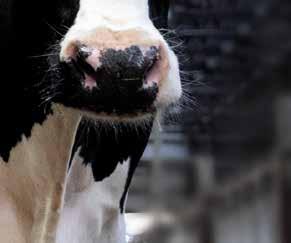

Cows: 65%-70% conventional and 25%-30% beef. We have bred some 2-year-olds to sexed semen that showed a good heat after their rst Lutalyse shot. If cows are not pregnant after the third breeding, we breed them to beef semen for the fourth and fth breedings. If they are not pregnant after that, we usually let them go. We have not done any embryo transfer or in vitro fertilization since we’ve been in our current facilities except for a few beef embryos.
What is your conception rate? How does this differ with different types of semen? Heifers: 69%. Conventional 63%, beef 60% and sexed 50%. Cows: 45%. Conventional 49% and beef 40%.
How does your heifer inventory affect your breeding program? We only breed for how many heifers we need to calve every month and keep tight to a specic number. We shoot for 16. We would like to start with 18 in case we lose a calf or one does not settle. We like to have that wiggle room or cushion in there, but we don’t want more than 20. Our facilities can’t handle it.
Tell us about your farm. Our 495-acre farm became a sesquicentennial farm in 2001. We can’t raise enough feed, but we grow as many of our forages as we can. Half of our crops are corn and half are alfalfa, and we also grow a little bit of rye. We expanded in 1999, building a freestall barn and milking parlor. Prior to that, we were milking on two separate farms in tiestall barns. We ship our milk to Rolling Hills Dairy Producers Cooperative, and we love the people there. Switching to Rolling Hills was one of the best decisions we ever made on our farm.
$359,600




JD S680 2014, PRWD, Duals, Chopper , 2349 hrs., 1668 Sep hrs., #531966.......... $195,000
JD S790 2019, PRWD, Duals, Chopper, 1770 hrs., 1426 Sep hrs., #532032........... $314,200

JD S660 2014, PRWD, Duals, Chopper, 1727hrs., 1317 Sep hrs., #532082 ........... $189,500
JD 9500 1989, 2WD, Duals, Chopper, 6463 hrs., 4553 Sep hrs., #543952................$20,000
JD 9500 1990, 2WD, Singles, Chopper, 5984 hrs., 3564 Sep hrs., #547007 .............$27,900

JD S690 2016, PRWD, Duals, Chopper, 2544 hrs., 1820 Sep hrs., #547267........... $219,900
Case IH 1660 1987, 2WD, Singles, Spreader, 5259 hrs., #547901 ..........................$16,500
JD S680 2012, 2WD, Duals, 2631 hrs., 1790 Sep hrs., #548165............................ $147,500




Case IH 2388 1998, 2WD, Singles, 3876 hrs., 2943 Sep hrs., #549406 ...................$34,900
JD S690 2017, PRWD, Duals, Chopper , 1433 hrs., 1028 Sep hrs., #549457.......... $280,700
JD S780 2019, PRWD, Duals, Spreader, 1562 hrs., 1131 Sep hrs., #549680 .......... $328,800

JD S780 2019, PRWD, Duals, Spreader, 1559 hrs., 1058 Sep hrs., #549682 .......... $333,900
JD S780 2019, PRWD, Floaters, 1604 hrs., 1145 Sep hrs., #549684 ...................... $339,100








JD S790 2018, PRWD, Singles, Spreader, 1452 hrs., 1055 Sep hrs., #549846 ....... $359,900
JD 9760 STS 2007, 2WD, Duals, Chopper, 2943 hrs., 2141 Sep hrs., #550117 .........$63,900
JD S780 2020, PRWD, Duals, Chopper, 1440 hrs., 941 Sep hrs., #550187............. $393,600
JD S790 2019, PRWD, Duals, Chopper, 1220 hrs., 944 Sep hrs., #550196............. $396,500
JD S690 2015, PRWD, Tracks, 2400 hrs., 1615 Sep hrs., #550872 ......................... $232,900

JD S680 2013, PRWD, Duals, Chopper, 2485 hrs., 1604 Sep hrs., #551147........... $165,000
JD S690 2012, PRWD, Duals, Chopper, 2311 hrs., 1645 Sep hrs., #551148...........
JD S780 2018, PRWD, Duals, Chopper, 1521 hrs., 1130 Sep hrs., #551736...........
JD S680 2014, PRWD, Singles, Chopper, 2709 hrs., 2076 Sep hrs., #551975 ........

JD S660 2017, 2WD, Duals, Chopper, 1575 hrs., 1180 Sep hrs., #552261 ............. $219,900 JD S780 2022, PRWD, Duals, Chopper, 449
Duals, Chopper, 427 hrs., 302 Sep hrs., #552839............... $589,900
JD S780 2020, PRWD, Floaters, Chopper, 1018 hrs., 803 Sep hrs., #553375 ......... $434,000
JD S780 2022, PRWD, Floaters, Chopper, 392 hrs., 323 Sep hrs., #553546 ........... $549,900
JD 9500 1990, 2WD, Singles, Chopper, 3900 hrs., 2600 Sep hrs., #553583 .............$24,000
JD S780 2022, PRWD, Duals, Chopper, 462 hrs., 345 Sep hrs., #553598............... $567,000
JD S790 2022, PRWD, Tracks, Chopper, 38 hrs., 21 Sep hrs., #553771 .................. $719,900
JD S780 2022, PRWD, Tracks, Chopper, 295 hrs., 238 Sep hrs., #554013 .............. $675,000
JD S770 2022, PRWD, Duals, Chopper, 270 hrs., 195 Sep hrs., #554014............... $560,000
JD S770 2021, PRWD, Duals, Chopper, 565 hrs., 486 Sep hrs., #554050............... $405,000
JD S780 2022, PRWD, Duals, Spreader, 240 hrs., 183 Sep hrs., #554094 .............. $587,500
JD S660 2012, 2WD, Duals, Chopper, 1643 hrs., 1188 Sep hrs., #554132 ............. $179,900
JD S670 2012, 2WD, Duals, Chopper, 2774 hrs., 1883 Sep hrs., #554281 ............. $129,900
JD S680 2014, PRWD, Duals, Chopper, 2260 hrs., 1355 Sep hrs., #554365........... $189,900
JD S790 2022, PRWD, Duals, Chopper, 334 hrs., 269 Sep hrs., #554381............... $610,000
JD S780 2022, PRWD, Floaters, Chopper, 236 hrs., 170 Sep hrs., #554623 ........... $599,000
JD S790 2018, PRWD, Duals, Chopper, 1314 hrs., 940 Sep hrs., #554633............. $354,900
JD S780 2022, PRWD, Floaters, Chopper, 216 hrs., 169 Sep hrs., #554706 ........... $579,500
JD S780 2022, PRWD, Floaters, Chopper, 243 hrs., 177 Sep hrs., #554707 ........... $578,500
JD S780 2022, PRWD, Floaters, Chopper, 138 hrs., 91 Sep hrs., #554708 ............. $589,500
JD S780 2022, PRWD, Floaters, Chopper, 183 hrs., 131 Sep hrs., #554709 ........... $584,500
JD S780 2022, PRWD, Floaters, 182 hrs., 139 Sep hrs., #554710 .......................... $583,500











JD S790 2020, PRWD, Tracks, Chopper, 804 hrs., 584 Sep hrs., #554727 .............. $529,000
JD 9870 STS 2010, PRWD, Duals, Chopper, 3394 hrs., 2260 Sep hrs., #554931.... $118,900

JD S680 2012, PRWD, Duals, Chopper, 2500 hrs., 2000 Sep hrs., #554973........... $129,900


ft., 5-Section Folding, #190857 ................................................ $57,500

JD 2210 2005, 38 ft., 3-Section Folding, #191986 ................................................... $28,000
JD 2210 2009, 55.5 ft., 5-Section Folding, #531369 ................................................ $44,900
JD 2210 2004, 27 ft., 3-Section Folding, #531751 ................................................... $29,900
Case TM 14, 55 ft., 5-Section Folding, #532837 ...................................................... $23,000
JD 2210 2012, 58 ft., 5-Section Folding, #533062 ................................................... $57,500
JD 985 2000, 50.5 ft., 5-Section Folding, #535303 .................................................. $15,500
JD 2210 2010, 57 ft., 5-Section Folding, #542886 ................................................... $47,900
JD 980 2000, 44 ft., 5-Section Folding, #545689 ..................................................... $16,500
JD 2230 2021, 60.5 ft., 5-Section Folding, #545925 ..............................................$162,000
JD 980 2000, 44 ft., 3-Section Folding, #546434 ..................................................... $16,900
JD 2210 2005, 43 ft., 5-Section Folding, #551803 ................................................... $33,500
JD 2200 2002, 60 ft., 5-Section Folding, #551815 ................................................... $29,500
Case IH TIGER MATE 200 2009, 54 ft., #552287..................................................... $43,500
Sunflower 5055-50 2012, 50.5 ft., 5-Section Folding, #552837 ............................ $39,900





JD 2210 2006, 60.5 ft., 5-Section Folding, #553154 ................................................ $29,900
Case IH Tigermate 2 2007, 44 ft., 5-Section Folding, #553875 ............................. $29,900
Case IH Tigermate 200 2009, 50 ft., 5-Section Folding, #554055 ......................... $39,900
JD 2210 2014, 25 ft., 3-Section Folding, #554138 ................................................... $42,500
Case IH 200 2014, 60 ft., 5-Section Folding, #554255 ............................................ $52,500
JD 2230FH 2019, 65 ft., 5-Section Folding, #554291 ............................................$152,000
JD 2210 2008, 33 ft., 3-Section Folding, #554294 ..........................................$39,900
JD 2210 2014, 41 ft., 3-Section Folding, #554297 ................................................... $47,500
JD 2210 2006, 45.5 ft., 5-Section Folding, #554617 ................................................ $29,900
Case IH
Advanced Dairy Spring Valley, WI 715-772-3201

Ederer Dairy Supply Plain, WI 608-546-3713
DeLaval Dairy Service

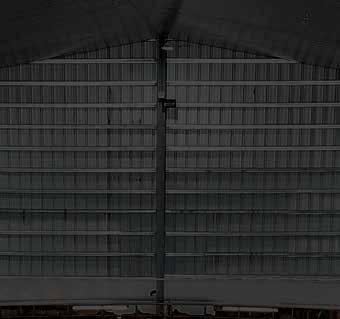

Kaukauna, WI 866-335-2825

Joe’s Refrigeration Inc. Withee, WI 715-229-2321



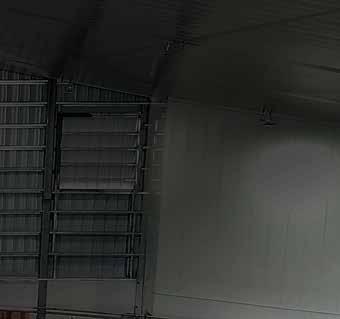
Mlsna Dairy Supply Inc. Cashton, WI 608-654-5106

Professional Dairy Services Arlington, WI 608-635-0267

Redeker Dairy Equipment Brandon, WI 920-346-5579



The Scharine Group Inc. Whitewater, WI 800 472-2880






Mt Horeb, WI 800-872-3470

Farm Systems




Melrose, MN 320-256-3276

Brookings, SD 800-636-5581
Advanced Dairy Mora, MN
320-679-1029
Pierz, MN
320-468-2494
St. Charles, MN
507-932-4288
Wadena, MN 218-632-5416
HILLSBORO, Wis. – Tyler
Winchel has been milking cows with his dad, Anthony, from a young age. The pair milked a herd of 32 cows.
When Winchel was 15 years old, he assumed management from his father when he took on another herd of 68 cows and milked them on a separate farm site.
“Dad milked that herd, and I milked this herd,” Winchel said. “He would help some before school.”
In 2018, Winchel added his father’s 68 cows to his herd when his dad got a job in town. The 28-yearold has been managing the combined herd ever since. Today, Winchel milks 60 cows in a 32-cow tiestall barn near Hillsboro. He normally has around 15 dry cows at a time as well.
Just a year after taking over the combined herd, Winchel began feeling the stress of dairy farming and decided to try a lifestyle change. He got a job as a logger and was sent over the road every week.
“I had never been off the farm before that,” Winchel said.
While Winchel was gone, his dad, his brother, Ryan, and an employee took over milking the cows so they would not have to be sold. Some weeks, Winchel returned home from the road on Sunday morning and had to leave again the same day.

It did not take long for Winchel to miss the farm life, and he quit the offfarm job to return to milking cows full time only ve months later.
“It’d be the hardest when you’d be gone all week and come home for the weekend,” Winchel said. “You’d see the cows and then have to leave right away again. It seemed like every day you missed it more and more.”
January marked one year since Winchel returned to the industry full time.
Cows are kept in two separate groups; one group is housed in the tiestall barn, and the other group is kept in a loose housing shed with corn stalk bedding. Winchel produces 160 acres of hay every year and farms 20 acres of ground corn. The cows are fed round bales of hay in feeders outside and a corn and protein mix in the barn while milking. Anthony helps on Sundays when he has time.
Winchel said nding labor is an obstacle.
Because Winchel is mainly on his own for chores and eldwork, switching cows proves to be a challenge. Typically, Winchel feeds grain and milks the rst group of cows before putting them outside. The switch group is then brought into the barn, fed grain and milked before switching groups one last time.
“It’s my biggest time killer right now,” Winchel said. “My milkers sit for half an hour while I’m switching
and graining. It takes half the time with two people, but it’s usually just me.”
In the summer, all the cows are on pasture and fed round bales in feeders. This simplies chores because all the cows are in one group.
Winchel’s plans include putting up a freestall barn to make chores easier and improve the cows’ housing situation.
“I may consider a parlor, but I want to get the freestall up rst,” he said. “I gure I can always milk in here (the tiestall barn) a few more years, and I could eventually get a parlor in.”
Winchel said the loose housing is difcult to manage in warmer months because there is no concrete. The bedding pack is difcult to clean and keep dry.
Anthony owns the farm, and Winchel plans to buy it from him within the next year. Winchel has been gradually bringing cows into the herd for more than a decade.
“I always bought cows as I could afford them,” he said. “Dad slowly culled his out, and now, I own most of them.”
Winchel raises every calf and
usually has a group of heifers to sell every year. He prefers to keep older cows around as long as possible. The rst two cows he ever purchased were bought as springing heifers from his neighbors when he was 14. One of them was nally culled last year at 16 years old.
“I don’t cull unless I have to,” he said. “If they’re a problem cow, they go. But otherwise, most of them make it 10 or 12 years.”
The original herd was comprised of registered Holsteins, but color was introduced when Anthony bought the second herd of crossbred cows. Now, the herd is a colorful mix of Holstein, Jersey and Brown Swiss. Winchel’s milk is shipped to Grassland Dairy in Greenwood.

Since Winchel began milking cows at a young age, he said he always knew he liked farming. Now that he has had a taste of life off the farm, he continues to dairy with a renewed dedication.
“I like being my own boss, and I just always liked being around the cows,” Winchel said. “I don’t mind being tied down.”










































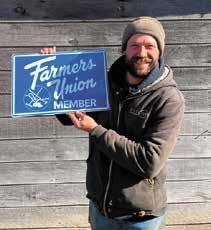




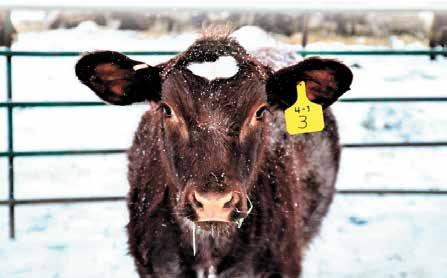





































 By Danielle Nauman danielle.n@dairystar.com
By Danielle Nauman danielle.n@dairystar.com








RIVER FALLS, Wis. – The experience of watching her family sell their cows led Michelle Stangler to the realization that becoming a storyteller of agriculture was the profession she wanted to pursue.
“Growing up on a small dairy farm is so much a part of who I am,” Stangler said. “Not only did I learn all the life lessons of work ethic and leadership, I was able to surround myself with the community of agriculture. I want to be able to share all of that as a storyteller.”
Stangler grew up on her family’s 50-cow dairy farm near Watertown and is now in her junior year at the University of Wisconsin-River Falls where she is pursuing a double major in agriculture marketing communications and journalism.

Stangler is serving as the president for the National Agricultural Communicators of Tomorrow. National ACT is a student professional development organization for those interested in agricultural communications with more than 400 members nationwide. The
group provides networking opportunities for its members and hosts contests for members to gain feedback on various projects they pursue.
“I had the opportunity to rst become involved with ACT as an individual member in the national organization by attending the Ag Media Summit,” Stangler said. “I felt inspired by my experiences. I have gotten so much out of my involvement and really gained a great support system and network of people from all over the country.”
Much like sharing the story of agriculture, Stangler is using her year as National ACT’s president to share the story of the organization and what it has added to her own professional development.
Her enthusiasm for what she has gained as a National ACT member led Stangler to bring the benets of the organization to her own college campus as part of the campus’s newly created Agricultural and Natural Resources Communications Club, where she also serves as president.

“There is really a growing need in the agricultural community for people to have access to the resources that allow them to develop their own voice as agricultural communicators,” Stangler said. “Sometimes it can feel difcult to step into that role of communicating the story of agriculture. It can be really hard to develop the support system that helps you grow as a communicator.”
Stangler said the best advice she can give to someone wanting to help share the true story of agriculture is to start with what they know best: telling their own personal experiences.


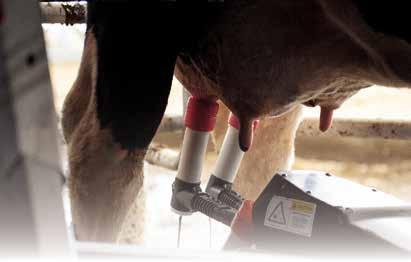
Taking any opportunity to join with likeminded individuals to grow and share experiences is another thing Stangler recommends. She is an active member of the UW-River Falls Collegiate Farm Bureau chapter and has spent a great deal of time working with the organization’s Ag Day on Campus.



As part of creating her own niche in agricultural storytelling, Stangler launched a daily podcast called “Positivity in Ag” where she focuses on a wide variety of topics and people pertinent in agriculture through a series of short segments that run four minutes in length.

“I saw a gap that was missing in podcasts,” Stangler said. “I’m a member of Generation Z and recognize,






typically, we have a short attention span before we are on to something new. Four minutes seems enough to be engaging without losing that audience.”
Broadcast journalism is an area that draws Stangler’s interest, and she works with the UW-River Falls campus radio station. She also writes for agricultural publications and has held numerous internships working in various aspects of agricultural communications.
“Broadcasting really appeals to me,” Stangler said. “I love interviewing people and sharing the story of agriculture from that perspective. A dream of mine would be to have an ag segment on an urban television newscast.”
Don’t miss this all dairy event, highlighting valuable updates in the dairy industry and new products and services giving you successful ways to improve your dairy operations.

•Free Ag Prayer Breakfast
•Over 300 Exhibitors



•Foundation Auction

•Educational Sessions


•Industry Experts
•Producers Attend for Free



Family: I am married to my husband, Jordy Parker. We have ve children –four boys and a girl – Paydin, Axel, Rextin, Kelia and Ender. We bought our farm almost ve years ago from my parents, Leroy and Laura Kieffer, and they bought a small hobby farm a half mile down the road.
Tell us about your farm. We have a small dairy farm with 64 cows in a tiestall barn. In the summer, we have our calves outside and tend to dry up more cows in the winter to keep the calf numbers down. We have our heifers at my parents’ barn, and my dad helps take care of those. We farm a little over 600 acres of land.
What is a typical day like for you on the dairy? I help with morning milking before getting the kids up and dressed for school. Depending on the day, I go back out and help with the milkhouse and feed cows. I then manage the house and the little ones that are still home during the day. I am also in charge of employee management, scheduling and cow information. I am chauffeur to the kids and all their activities. In the summer time, I help with parts runs and meals to the elds.
What decision have you made in the last year that has beneted your farm? We recently put in a bag pad to do more feed bags for our cows and heifers, which has helped with our feed quality.
Tell us about your most memorable experience working on the farm. I have so many amazing memories on this farm, and I’m so happy I get to raise my kiddos on the same farm and make so many memorable moments on this farm.
What have you enjoyed most about dairy farming or your tie to the dairy industry? I enjoy having more time together as a family. My oldest is getting more and more busy with all his activities, so when I get to see all my kids working together, it feeds my soul.
What is your biggest accomplishment in your dairy career? When we rst bought the farm, we added 10 milking and comfort stalls by removing some heifer pens. We moved the heifers to my parents’ small heifer barn. Then, we focused on nutrition to increase milk supply. We did a lot of research to nd the best pricing to reduce the costs.


What are things you do to promote your farm or the dairy industry? Because our kids are still young, I strive to teach them a good work ethic and try to make it fun and enjoyable. The kids also attend Wisconsin Farmers Union Youth Camp where they learn about co-ops and working together.
What advice would you give another woman in the dairy industry? Set boundaries for yourself and your family, have patience and know you will be late to everything. Always tell your farmer two hours earlier and hire someone to help you move animals with your husband.
What is a challenge in the dairy industry you have faced and how did you overcome it? Sometimes it can be lonely farming and having small kids. Talk to friends who understand and try to ride along in the tractor or to get parts.

When you get a spare moment, what do you do? We like to have game nights and res in the winter.
KUHN

Knight VT 200 Series twin-auger Vertical Maxx® mixers are ideal for small to medium dairy and beef producers looking to put a quality ration in front of their animals. The VT 200 Series features multiple improvements that will provide enhanced performance and longer, more reliable service. These improvements include updated front conveyors, better door-to-floor sealing, heavier high-wear auger flighting and EZ-mate scale system. The VT 200 Series mixers range in capacity from 320 – 760 ft3, and are available in trailer and truck configurations. Multiple configurations, single- or 2-speed drive options, along with multiple discharge options, allow machines to be tailored to every feeding operation’s needs.
WAUMANDEE, Wis. – Caring for almost 200 animals is a group effort at Anchorage Acres near Waumandee.
Don Dittrich said the farm provides opportunities for his children to have fun and learn responsibility through day-to-day chores and attending fairs.
“The kids like to show, and I think that’s what keeps them on the farm,” Don said.
Don milks 92 cows in a double-6 herringbone parlor with his wife, Billie, and their seven children: Jordon, Korlen, Barbara, Donniejo, Cecelia, Eddie and William. The Dittriches also raise their youngstock.
Billie works for Farm Service Agency and the children help their dad with chores between school and sports.
Throughout 40 years of obstacles and the rising and falling of milk prices, Don has remained committed to keeping the dairy functioning. Sometimes that meant taking a job off the farm while his family stepped in at home, but it was always with the benet of the dairy and the opportunities it provided in mind.

Korlen is in charge of mixing feed, hauling manure and managing eldwork in the summer. Barbara and Donniejo attend the University of Wisconsin-River Falls and help on the farm

DC - 1125 Series Dump Carts have a durable and time proven box design to keep continuous harvest production. DC-1125 Series carts have high floatation tires that create less damaging impact on your fields and harvesting equipment. DC-1125 Series now also comes standard with the fold down gate and ground level grease banks.



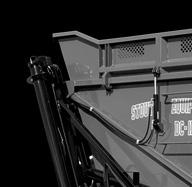
when they are able. The younger kids pitch in between school and extracurricular activities.
The farm consists mostly of registered Holsteins, but color has been introduced as the kids purchase their own animals. Cecelia used money she earned at the fair to buy two Jersey heifers last year, one of which received junior champion at the Buffalo County Fair.
William introduced the Brown Swiss breed with the purchase of a heifer last year. He is working on getting her ready for shows this summer.
Korlen has a cow that is 9 years old, which he bought as a calf for a 4-H project. She has had eight calves in seven lactations and has multiple daughters and granddaughters on the farm.
“He has enough to start his own little dairy herd,” Billie said.
The kids also invested in a Red and White Holstein.
Don’s parents bought the farm in 1968 when he was 5 years old. As the youngest in the family, he was the only one who joined his parents in the operation. Originally, cows were housed in a 63-cow tiestall barn which burned in 1999. The cows were moved to a neighboring farm for eight months while the current parlor and freestall barn were built in June 2000.
“We built this in 2000, and it’s been a slow return on investment ever since,” Don said.
Turn to DITTRICH | Page
PARTS DISCOUNTS THE ENTIRE MONTH OF FEBRUARY
USED TRACTORS
USED COMBINES
› Self Unloading

› Self Loading (If Tires Are Stacked Properly)



› Haul Up to 80 Sidewalls (Varies Depending Loader) or 110 with wheel loader tire shooter
› Reach over 18’ Cement Walls (Varies Depending Loader)
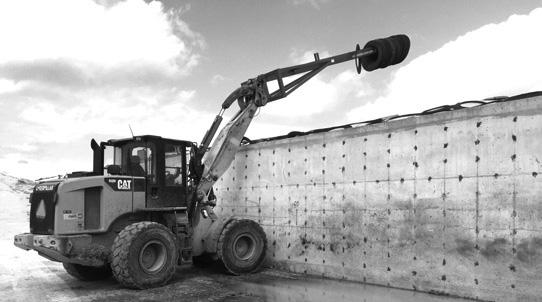
› Drop Sidewalls 22’ from Edge of Plastic on skid steer or telehandler, and 30’ with wheel loader tire shooter
› Custom Fit Any Skidsteer, Telehandler or wheel loader
› Use with Sidewalls or Full Tires
› Powder Coated

› Typical customers say it saves half the time or half the labor; some say both

715-613-5051
USED SKIDSTEERS
Case 90XT cab 3900 hrs .............$23,500


Case 1840 ’94 2800 hrs ..............$15,900
NH L220 3200 hrs.......................$24,500
Mustang 2076 ’05 Cab ..............$25,500
Con




No cows were lost in the re, and Don bought 20 heifers to expand the herd for the new setup. At that time, the Dittriches began feeding a total mixed ration.





Today, the farm consists of 170 tillable acres plus an additional 20 acres which are rented from Don’s brother. Previously, they hired their crop work done, but Korlen has invested in a tractor and baler since joining the farm full time. Don said Korlen also harvested the high-moisture corn last year which yielded a better crop than in previous years.
“Our production has increased by having better feed,” Don said. “Our corn is a lot wetter, and you have the feed when you want it.”
The Dittriches have had success with their fresh cow management by making sure the fresh cows are milked rst and therefore have more time at the feed bunk with less competition. Replacement heifers are raised on-site.
One challenge the family faces is land price in their area. With Buffalo County being a popular hunting area, renting land is a challenge, which makes the possibility of expanding the herd almost impossible.
“People get into bidding wars over land,” Billie said. “Sometimes it goes for $10,000 an acre.”



At one point, the Dittriches were milking 130 cows and buying the extra feed required.
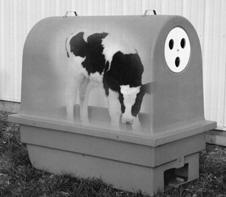


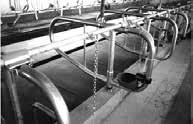


“It got to the point where it wasn’t worth paying to rent the land,” Don said. “So, we just cut down on the cows to what we can handle.”
The family agreed their favorite part of farming is the shows they attend with their children.
“We’ll keep the dairy going to see if there’s any interest,” Don said. “We keep milking with the hope of keeping the farm for a third generation and to expand protability.”

Weiland Dairy


Roger, Tammy, Brady, Brett and Emiley Weiland
Columbus, Wisconsin Columbia County
1,150 cows between two dairies



How did you get into farming? Weiland Dairy is Roger’s home farm. In 1990, Roger became one-third partner in the operation with his dad and uncle – the same year he and Tammy got married. They farmed as partners until 1995 when Roger and Tammy bought the cows and 50 acres. It was a 100-cow dairy milking in a stanchion barn. Roger’s passion was cows and genetics. Family time was also important to him and Tammy, whose mission was God, family and business in that order. They put up a 4-row freestall barn and double-6 herringbone parlor converted from a calf barn that they continue to milk in today. Brady and Brett are the fth generation at Weiland Dairy. Brady worked on the dairy while he was attending Madison Technical College to become a diesel technician. After graduation, he took what was supposed to be a temporary feeder position on the farm. Instead, he fell in love with the cows and began rethinking his career choice. His parents said if he wanted



to stay on, he would need to do some schooling in the agricultural eld. He completed the University of WisconsinMadison Farm and Industry Short Course program in the spring of 2014. Brett also attended one year of short course before pursuing a four-year degree at UW-Madison and UW-Platteville in agricultural business management with a minor in commodity and marketing analysis. In 2015, Brady became part owner of the farm. The family added on a barn for 100 cows and went from 320 to 420 head, with Brady purchasing the additional cows. In 2019, the family doubled the herd size overnight when Brady and Brett purchased a neighbor’s farm. Today, Roger and Tammy own 50% of the original dairy, while Brady and Brett and his wife, Emiley, each own 25%. The brothers own the second dairy 50/50.
What are your thoughts and concerns about the dairy industry for the next year? Low revenue but high output is a concern we currently have. We work hard to make sure we’re doing risk management. Our strategy is to watch expenses and ensure they are lower than our cost of production. It’s important to protect margins, and we are very active on risk management for milk and inputs.
We are prepared for falling milk prices and inputs to stay high.
What is a recent change you made on your farm and the reason for it? We began using articial intelligence software by Cattle Care to analyze our camera footage in the parlor. We have two cameras – one










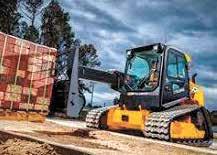



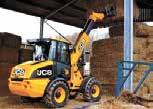


on each end of the pit. The software scores each milker, looking at pre-dipping, wiping, stripping, post-dipping, etc., and if they miss something, the software catches it. We’ve never seen anything like this software; it’s incredible. The technology sends alerts if someone is getting aggressive or using the same towels on mul-
1,150 cows on two dairy
tiple cows, for example. The system helps us when doing performance reviews. We’ve also started doing pregnancy checks via blood sampling. As a result, our vet is checking a lot fewer cows. We’re repurposing our veterinarian for training and staff compliance
and using him less for sleeving cows, which is also a little less invasive for cows. We also have done a lot of estate and transition planning. All of us have trusts and wills, and we worked hard getting that planned out.
Tell us about a skill you possess that makes dairy farming easier for you. Watching numbers and keeping a close eye on the nancials of the business. We regularly run reports and use metrics. Before we take on something new, we do a budget and cash ow analysis, and we only invest in things that have a payback of three years or less.
What is the best decision you have made on your farm? We had an opendoor policy with the boys about coming back to farm with us. Being positive about the dairy industry and allowing our sons to come back on their own terms was important to us. We wanted it to be their decision. We think it’s awesome that they came back, and we think they are doing a fabulous job.
What are three things on the farm that you cannot live without? Our employees, dairy software and good vendors. We couldn’t have our family business without employees and family helping. It wouldn’t be possible without their labor. We have good neighbors and vendors who share our values, and we value the relationships we have with these people. We work closely with consultants and have an advisory team we cannot live without. We meet quarterly, and our team includes our vet, nutritionist, lender, tax accountant, another industry professional and one non-industry professional. We use herd management software like DairyComp on a daily basis. The rst thing we do every day is run lists for vaccination, reproduction, etc. QuickBooks and one™ feed are other software programs we rely on regularly.

What strategies do you use to withstand the volatile milk prices? We use forward contracts, Dairy Revenue Protection, options and the Dairy Margin Coverage program. We also do contracting on the input side with feeds. Especially after we bought the other farm, we had to get pretty aggressive and make sure we wouldn’t go backward. We work closely with our brokers and are looking at these things every

day. We have milk and feed locked in through 2023 and have targets for 2024. It takes out a lot of the stress. We know we’ll be here a year from now. When you take out the lows, it’s going to take out the highs with it, but it all averages out.



How do you retain a good working relationship with your employee? We treat our employees like we would want to be treated. We take the time to greet them and ask them how their day is going and how their family is doing. We let them know they are appreciated. We hold monthly staff meetings and have a Spanish translator who comes once a month to help train employees. We bring breakfast or lunch a couple times each month, and in the summer, we have a cookout. We also hold a Christmas party every year. We watch what is being paid to employees – not only in our industry but in other industries as well – to make sure we are competitive. We provide housing and paid vacations and give our employees exibility in their schedules. We do performance reviews twice a year so employees are aware of the things they are doing well and things they may need to work on. Brady also speaks Spanish which has proven helpful in communicating with employees. As a family, we hold a weekly business meeting to discuss nancials, our to-dos and projects we’re working on.
What do you enjoy most about dairy farming? The people and the cows. This is a pretty close-knit industry, and we take a lot of pride in what we do. We love working with our employees, fellow producers and neighbors. We take pride in the quality of product we produce and what ends up on the consumer’s table. Producing top-quality products is something we enjoy about dairy farming.
What advice would you give other dairy farmers? Pick your top three priorities and keep them in front of you while surrounding yourself with positive, intelligent people. Also, it shouldn’t be farm, farm, farm. Take some time for yourself and your family. You should also prepare for the inevitable by doing transition and estate planning. Finally, get outside of your comfort zone and be your own advocate.
What are your plans for your dairy in the next year and ve years? We want to get in a position so that when opportunities arise, we are ready for anything. Growing our efciencies and guring out what we can do better are goals we have. We would like to implement more technology on the farm and are researching activity monitoring systems. We are also interested in sustainability practices and are researching new technologies in this area.
How do you or your family like to spend time when you are not doing chores? Roger and Tammy like to travel and have family and friends over. In the summer, we go for a week up to northern Wisconsin as a family. In the fall, we do a family retreat after the harvest is done. Last year, we went to the Smoky Mountains and had a blast. Brett and Emiley also like to camp. Brady and Brett joined the re department recently, and we are also active in our church. In addition, Brady is on the PDPW board and the Wisconsin Beef Council.
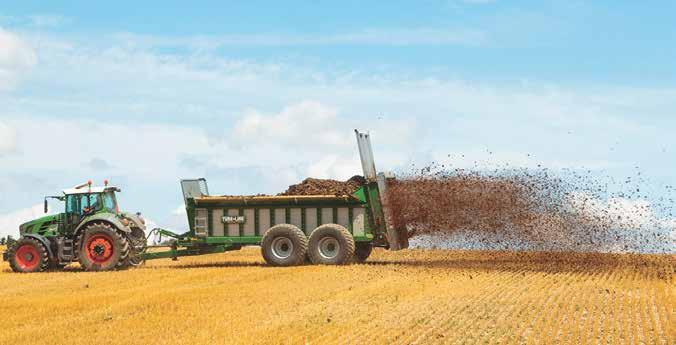


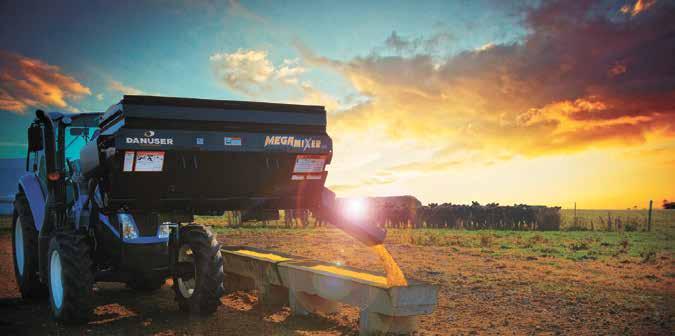
I was 10 years old when I bought my rst calf. She was a registered Holstein named Hopscotch. I will never forget the day we met.
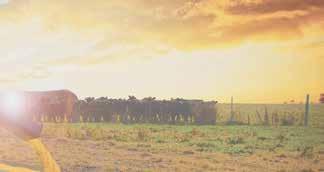
It was an unseasonably hot, sunny Saturday in April – the day before Easter. My dad asked if I wanted to go to a cattle sale with him. Of course I said yes and hopped in his Ford pickup truck. Away we went, headed to the Show Opportunity Sale in Weyauwega, Wisconsin. I was on the lookout for a show calf, and when I saw her, it was love at rst sight.
She was tall and long and every bit dairy. She held her head high above the box stall and stared at us, catching our attention from far away. She was super friendly, and when I pet Hopscotch for the rst time, I knew we were going to be best friends.
When Hopscotch entered the sale ring, my dad told me to start bidding. The auctioneer did not know if he should take me seriously at rst. But when my dad nodded to him, he took my bid and kept taking it until no one was bidding against me. When he struck the gavel and yelled, “Sold,” I was ecstatic. I paid $1,025 for Sky-M Simon Hopscotch with money from my savings account. In the weeks and months that followed, I had so much fun caring for her. I practiced leading her and getting her ready for the fair. Hopscotch was the center of my world. When I wasn’t spending time with her, I was thinking about her. She lled my daydreams at school, and I could not wait to get home each day so I could run down to the barn and be with her.
By Stacey Smart Staff Writer

That summer, I showed Hopscotch at both of our county fairs and our district show. She cleaned house at the rst fair, winning the fall heifer calf class and being named grand champion. We also won the showmanship class for my age group. At the district show, she earned a blue ribbon, standing in the top half of a rather large class. At our second county fair, she was top of her class once again and earned reserve grand champion honors as well as best junior owned.
Hopscotch was special, and she knew it. She became part of the family, and on Christmas Eve, 1988, she had her rst calf – a heifer I named Hope. She was one of the best Christmas presents I ever received. Hopscotch had many calves in her lifetime, and her offspring helped pay for my rst car and also helped pay my way through college.
For every birthday, she got a cake made out of grain, haylage, corn, etc., with pieces of hay acting as candlesticks. We also sang to her, and she received a homemade birthday card, balloon and present, such as a new collar. She always had a different collar than the rest of the herd – usually something bright and ashy. On her golden birthday when she turned 11, we celebrated with two cakes –one for her and one for us humans. On the only birthday I could not make it home for, my dad held the phone up to Hopscotch’s ear so I could sing “Happy Birthday” to her.
I regularly groomed Hopscotch and gave her baths, clipped her tail and udder, and made sure her switch was freshly washed. She basically looked camera-ready at all times. I often took her for walks around the farm – a tradition that did not die as we both grew up. I also made a point of visiting with her after every morning and evening chore time before heading to the house.
She had a personality everyone liked, was nice to look at with a score of VG-89 and also paid her way by what she put in the bulk tank. My dad used to say, “I wouldn’t mind having a barn full of Hopscotches.”
Hopscotch’s favorite stall was the last one on the side of the barn that faced east. If another cow dared to take it before she could get there, Hopscotch would patiently wait in the aisle for one of us to back the other cow out of the stall so she could have it.
We grew up together, and Hopscotch was around for many of the major milestones in my life, like when I graduated from high school and college, when I got married and when I had my rst child. As time went on, I noticed the hair on her face starting to turn gray. When she was 15, Hopscotch retired from milking and had the freedom to spend her days how she pleased.
Hopscotch lived to be 17 years old, passing away peacefully of old age while resting in her favorite pasture. She is buried on my parents’ farm. We held a funeral service when she died – complete with music, prayers, photos, owers and a eulogy. After all, she was part of the family.
Hopscotch was a friend I could always count on, an astute listener and a condante that always brought a smile to my face. This unforgettable animal was an important part of my childhood and beyond, and we made countless memories together. She lived a full and happy life, and I am so thankful for all the wonderful years I had with my favorite cow, Hopscotch.


My rst paid job that I had as a child was pulling weeds in my grandmother’s garden. She would be nearby pulling weeds too. It was a supervised position that we could do together while we talked, and she could watch over me to be certain I wasn’t accidentally pulling little ower or vegetable seedlings. I knelt on the ground with a pail near me, and she paid me one cent for every weed. If I could stick it out for a while, I might have pulled a pail or two full, earning $1. She was pretty good at working math into weed pulling, so I knew 100 weeds equaled 100 pennies, or 20 nickels, or 10 dimes, or 4 quarters or a $1 bill. I was only about 5 years old. Eventually, as I got older, I would pull more weeds and earn more money. As I felt more condent working around the garden, I was taught how to use the push lawn mower. I learned how to mow around the gardens and to blow the grass clippings away from the ower or vegetable beds. I would sweep up the clippings that were on the sidewalk and rake the grass clippings into piles to haul in a wheelbarrow to the chicken coop to feed the chickens. I don’t remember what I was paid, but I know I felt trusted. It was an important job. These are memories that have inuenced my life to this day.
like family. I watched this young man get lost going from one building to the next and take the long way around to get a tool. We identied that he broke rakes and pitchforks without admitting he did. We tried to keep the relationship going, but it was frustrating.
As the working climate changed after the pandemic, he found that much more money was easier made at a big hardware store. He decided he didn’t like cows after all.

As we continue to recover from the difculties of the pandemic, the impact of ination, and the fear of another recession looms overhead, we will continue to feel pushed to nd the help we need. Restaurants
By Tina HinchleyWhile in high school, I worked at Kentucky Fried Chicken for a minimum wage of $3.35 per hour. I worked on weekends and eventually after school, when I got my driver’s license. Receiving my own paycheck, getting a bank account and managing my money helped purchase my rst car. Back in the 1980s, everyone wanted to have a job, and even though the recession was going on, money was always important to have in your pocket. I bought my own lunch for $1.50 per day.
I have been short-staffed on the farm just as many other farms and businesses are today. I see that things have changed. Parents give their children money, and the idea of working for it has disappeared. There isn’t a push to get a car when there is a spare one in the driveway. The struggle to nd help is devastating to many farms and businesses.
It wasn’t too long ago that college students would need on-farm experience for some of their degrees. I would have a list of students that would come for six weeks or maybe a full semester. After the pandemic, things haven’t been the same. Requirements have changed, and the atmosphere around campus has been disrupted. Declining enrollment and online classes are the new normal.
I try to nd kids nearby to help do chores and work with fetching the cows to the robots. I’ve been reaching out to the high schools to see if the counselors know of any students who might be interested in working. The job would be working around, and with, animals and working outdoors. This would be a job that would require someone to lift 50 pounds. It would have paid training and supervision for an extended period of time. We will pay for boots, overalls and sweatshirts as a work uniform.
But, the big question is how much does this job pay.

In the recent past, we had a 14-year-old high school student who started at $8. As he went through high school, he received raises with employee evaluations and went up to $12 by the time he had graduated. He had a difcult upbringing and was challenged at school. We took him under our wing and treated him


are closed with a note on the door saying, “Sorry, not enough help.” Gas stations and big hardware stores have resorted to offering enormous wages to employees.
The amount is too high for us to compete with. This leaves us seeking help from others who want to work. They show up on time, happy to do chores and like working with cows.


Tina Hinchley, her husband Duane and daughter Anna milk 240 registered Holsteins with robots. They also farm 2,300 acres of crops near Cambridge, Wisconsin. The Hinchleys have been hosting farm tours for over 25 years.
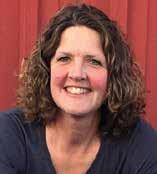

Last week, as the temperatures plummeted again, we told ourselves to look forward to Saturday when the mercury would climb. Saturday was supposed to be a lovely warm day to reward us for battling another cold stretch. Saturday was supposed to be a day to get all my chores done and bust a move toward town to cheer Finley and his team on while they played basketball. Saturday was supposed to be a day when we celebrated Stacy’s 40th birthday with a fabulous surprise party.
Saturday rolled around, and quite the opposite happened.
Ira has become the chief feeder on Saturday mornings. It gives Peter a day off, and I know it makes Ira feel good that he is trustworthy and capable of being the guy that can ll in. As I was getting layered up for chores, my phone buzzed: “Mom, you have a cow down in pen ve.”
“Are you sure?” I replied. “I don’t really want a down cow today. Ask her to change her mind.”
“Mom – (exasperated sigh) – her back legs are going different directions. She’s by the gate.”

Is it better to know what a disaster you are walking into or better for it to be a surprise?


I hastened my steps to the barn, then grabbed a halter, the hobbles, a bucket for throwing sand under her and extra muscle in the form of José.
Poor Natasha, a beautiful rst-calf heifer, was denitely split and uncomfortable. Her back was rubbed off, so all I can assume is that she was in heat and things got too rowdy.
After securing the hobbles on her back legs, we tied her head to her leg so she could not wiggle into a more precarious position. In that position, she was set up perfectly for a skid loader bucket transport to the straw pack pen. Ira delivered us the skid loader then
had to doctor the radiator on the mixer tractor that decided to overheat on him.
We carefully rocked Natasha forward then back into the biggest bucket and headed off to the pen. She may quite possibly become meals for a neighbor. Her legs do not seem to cooperate with her about getting up as she maneuvers around on the pack. It bums me out; her mom was a favorite of mine, and she was looking to be just as big and productive.
It was milk tester Saturday, which of course I had forgotten all about until I rounded the corner heading to the barn and spied their trucks. I groaned. I had no treats for them, and this meant popping cold hoses on and off for me this morning.
By

After milking and sampling my hospital pen, José popped into the milkhouse distraught because the calves in the pavilion had no water and were being vocal about their thirsty throats. He had tried all the normal tricks to thaw the water and nothing was working. We lled more pails of hot water, and José left to try again. I called my dad, and he said we had to tear the panel off the waterer and pour hot water over the pipe underneath. So, my Saturday sidekick, Gerald, and I dropped our vaccination supplies and ran to stop José from his Plan B of lling a water tank for the calves and running a quarter mile of water hoses to do so.
A solid 40 minutes later, crouched on my knees on frozen (thankful for that) manure, Gerald and I heard that wondrous sound of water nally coming back out of the spout. The calves were as overjoyed as we were as they fought to gulp the water down. Gerald and I headed to move the dry cows and said farewell to the notion of making it to town to watch Finley play ball.
Stacy and the crew stopped by at the house for birthday cake festivities before she went to nap. She caught the “crud” that all three of our big boys had over the past week and was looking forward to passing the day on her couch. The surprise party was called off. You can’t enjoy a party when you feel awful on top of trying not to give it to anyone else. As the boys curled up on the couch, José popped in the house after feeding the calves in the old barn and asked if I wanted to go shing. I was perplexed.
Turns out the rst two calf pens in the barn were ooded. There was standing water in the main alley. It was a mess. He grabbed lunch then headed back out to jump in the skid loader to start the task of cleaning the pens. I put Cora down for a nap then suited up to try to gure out how this could have happened. Two hours of cleaning and close inspection later, all we can gure is that the oat must have stuck in the waterer. This could explain why I had low water pressure in the house when I rst came in for lunch. Uffda. We’ve never had that happen before. It must have been the luck of the day.
By day’s end, it was indeed warmer out. I was thankful I had good help around me all day to assist with the unexpected problems. And as we always say, “It could have been worse.”
Jacqui and her family milk 800 cows and farm 1,200 acres of crops in the northeastern corner of Vernon County, Wisconsin. Her children, Ira, Dane, Henry and Cora, help her on the farm while her husband, Keith, works on a grain farm. If she’s not in the barn, she’s probably in the kitchen, trailing after little ones or sharing her passion of reading with someone. Her life is best described as organized chaos, and if it wasn’t, she’d be bored.




 Veterinary Wisdom
By Jim Bennett Columnist
Veterinary Wisdom
By Jim Bennett Columnist
Progesterone is a steroid hormone that is produced by the corpus luteum, or CL as veterinarians commonly say. Progesterone prepares the uterus for pregnancy and helps maintain the pregnancy by its effects on the uterine lining. Progesterone is also produced by the placenta later during pregnancy. Progesterone is important for successful conception and maintenance of pregnancy. However, the presence of progesterone at the wrong time can make getting cows pregnant more difcult. Thus, the correct amount of progesterone at the right times is important to ensure adequate reproductive performance in dairy cows. This is critical for successful use of timed A.I. programs.
High progesterone is benecial at the time of the rst GnRH injection of an ovsynch protocol, while low progesterone is benecial at the time of the second GnRH injection and at breeding. Many modications to timed A.I. protocols have been researched or recommended to attempt to increase the percentage of cows with optimal progesterone levels at the right time. For example, if the rst shot of an ovsynch protocol is given randomly to normal, cycling cows, a signicant percentage will not ovulate, will not form a CL and hence will have a low concentration of progesterone during the follicular growth phase, resulting in subfertility and higher risk for pregnancy loss and twinning. Pre-synchronization protocols were developed to reduce the percentage of cows that are in a low progesterone phase at the rst GnRH injection. However, even pre-synchronization protocols will not necessarily
synchronize cows that are not cycling and ovulating normally. Thus, more elaborate pre-synchronization protocols have been developed, such as double ovsynch for example, in an attempt to induce ovulation and create a functional CL that will be producing progesterone at the time of the rst ovsynch GnRH injection. Though not originally de-signed for this purpose, CIDRs can be used to provide progesterone in ovsynch protocols where no CL is present. A CIDR essentially replaces the functional CL, and its use can achieve similar conception rates to cows with a CL.

In normal, fertile cows, blood progesterone levels decline rapidly near the end of the estrus cycle. This occurs because the CL regresses due to prostaglandin release. In ovsynch, we inject prostaglandin to regress the CL. However, a young CL, as found when a cow has ovulated following GnRH seven days prior, does not necessarily fully respond to prostaglandin. Also, for unknown reasons, young CLs respond better if there is another, mature CL present at the same time. When the CL does not fully regress, progesterone levels stay too high, which can drastically reduce fertility. A variety of strategies have been used to solve this problem, including an additional prostaglandin injection 24 hours later and an increased dose of prostaglandin. Studies mostly have shown that an increased dose does not work as well as an additional dose to regress the CL, so an additional dose of prostaglandin has become a very common practice in ovsynch protocols today. An additional prostaglandin dose was rst shown to be effective in a double ovsynch protocol, and it was believed that it would be more effective there than in a simple ovsynch protocol because cows in the double ovsynch protocol are much more synchronized and thus a greater proportion of them will have young CLs. However, a recent study by Holper, et. al, in the January Journal of Dairy Science showed an increase in the percentage pregnant per insemination of over 6 points
in a standard ovsynch protocol. An additional dose was particularly effective in cows that did not have a CL at the time of the rst GnRH injection in an ovsynch protocol. Cows with no CL that received two doses of prostaglandin had 47.9% pregnancies per A.I., while cows with a double dose had 32.7%. In this study, cows that were given CIDRs that had more vaginal discharge had higher rates of pregnancy per A.I., and the overall accuracy of detection of a functional CL by transrectal ultra-sound was 87.2%. The optimum cutoff was a 20 mm diameter of the CL. Increased vaginal discharge might be due to higher vaginal blood ow that may result in increased hormonal absorption. Accuracy




The correct amount of progesterone at the right times is important to ensure adequate reproductive performance in dairy cows.



of diagnosis of a CL capable of producing progesterone is important if one wants to use CIDRs to increase fertility in cows without mature CLs.
The estrus cycle of a cow is an intricate dance of hormones and other factors. Understanding the role of progesterone and other hormones is critically important to designing timed A.I. protocols for herds. The best source to answer questions regarding the optimal reproductive protocol for your herd is your veterinarian. Do not be shy about asking.
Bennett is one of four dairy veterinarians at Northern Valley Dairy Production Medicine Center in Plainview, Minnesota. He also consults on dairy farms in other states. He and his wife, Pam, have four children. Jim can be reached at bennettnvac@ gmail.com with comments or questions.

JD 8600 2018, Kernel Processor, PRWD, 1651 hrs., 778 CH hrs., #188792 ................ $342,000
JD 7450 2008, Kernel Processor, PRWD, 5410 hrs., 3720 CH hrs., #547277 .............. $110,500
JD 8800 2016, Kernel Processor, PRWD, 2602 hrs., 1679 CH hrs., #175182 .............. $268,100
JD 8500 2016, Kernel Processor, PRWD, 2231 hrs., 1180 CH hrs., #555984 .............. $259,000
JD 8300 2022, Kernel Processor, PRWD, 29 hrs., #537501 ....................................... $459,000
8700 2016, Kernel Processor, PRWD, 1840 hrs., 1103 CH hrs., #525709 .............. $324,000
JD 8700 2018, Kernel Processor, PRWD, 1701 hrs., 1069 CH hrs., #541389 .............. $348,500
Claas 970 2018, Kernel Processor, PRWD, 2257 hrs., 1639 CH hrs., #533174 ........... $299,000

JD 9700 2020, Kernel Processor, PRWD, 1153 hrs., 653 CH hrs., #543646 ................ $503,000
#532728 ............... $399,900
JD 9600 2019, Kernel Processor, PRWD, 1224 hrs., 811 CH hrs., #532049 ................ $409,900






JD 7780 2013, Kernel Processor, PRWD, 3366 hrs., 2109 CH hrs., #274502 .............. $169,900
JD 9800 2020, Kernel Processor, PRWD, 1414 hrs., 942 CH hrs., #554135 ................ $459,900
JD 6810 1996, Kernel Processor, PRWD, 3999 hrs., 2676 CH hrs., #552363 ................ $39,900
JD 8600 2016, Kernel Processor, PRWD, 1650 hrs., 1200 CH hrs., #555841 .............. $289,000
JD 8800 2017, Kernel Processor, PRWD, 1727 hrs., 904 CH hrs., #544616 ................ $339,900
JD 7400 2002, Kernel Processor, PRWD, 5112 hrs., 2623 CH hrs., #553603 ................ $87,900
JD 9700 2020, Kernel Processor, PRWD, 957 hrs., 500 CH hrs., #552460 .................. $524,900
JD 9600 2019, Kernel Processor, PRWD, 1720 hrs., 1130 CH hrs., #553763 .............. $349,900
JD 7980 2014, Kernel Processor, PRWD, 3400 hrs., 2366 CH hrs., #532823 .............. $157,000
JD 8700 2016, Kernel Processor, PRWD, 1467 hrs., 933 CH hrs., #532572 ................ $339,000



They say nothing is free, but then, maybe those people never lived in Minnesota.

For anywhere from four to seven months of the year, our soil magically turns to concrete. This is handy if you don’t have quite enough concrete to keep all the critters and feed out of the mud. Just wait for November or December to roll around, and suddenly, mud problems disappear as the freezing temperatures blow in. For free, your whole farm has turned to one giant, quite hard, concrete-like surface.
I dislike mud. Partly, I dislike it because we store feed in bags, and feeding out of bags when it’s muddy is a nightmare. Partly, I dislike mud because we are a grazing farm, and half the year, the cows are in the pastures harvesting their own food and spreading their own manure which means they do a lot of walking down paths to get to the pastures. Those paths are not fun for us or the cows when it’s muddy. Also, on a farm where the cattle have no reason to be in a barn most of the year, the facilities tend to be a bit conservatively sized. No sense in spending money on barns no one is in most of the year. Free concrete solves both those problems.
Manure handling is a time-consuming task especially if you don’t have a manure pit to just












squeegee the poo into. I know, for people with liquid manure systems, frozen manure chunks are a pain and create extra work, but for me, frozen manure is a blessing. We clean our freestall twice a day, and it takes entirely too much time. Regularly, we’re scooping up half-full buckets of sloppy manure that splatters on everything when dumped in the spreader. When it’s cold though, I can scoop big full buckets of now semi-solid manure and pile ve days’ worth of manure where usually I can only t one to two days’ worth. Another bonus is we can
From when I started writing this article to my nishing it, the temperature has swung from 20 degrees below zero to 30 above. No more frozen manure but at least the ground is still nice and hard. Soon though, the sun will be out long enough to get some warmth going and we’ll transition to spring. Here’s hoping the mud season will be short and the grass starts growing early. After the drought we had last summer, and also the previous summer, feed supplies are pretty tight around here. We could use an early spring even if it means the free concrete melts and we have to deal with mud.
load the frozen manure in our dump wagon and pile it in a eld to be hauled on the elds or pastures when the snow melts off, and the nutrients will actually stay where we put them. It’s crazy, but the inside of that pile will still have chunks of snow in it when we haul it in April or May, sometimes even June.
Speaking of big temperature swings, Emily and I are headed to a much warmer and more mountainous country for a week. It seems based on the weather forecasts we’ve been following that it has been raining there constantly and probably will be when we are there too. Even if it’s muddy, I’m pretty sure we’ll enjoy the trip. Hopefully our Spanish-speaking skills will be good enough to chat with some of the dairy farmers there. Look forward to an article in the future about dairying in a different part of the world. In the meantime, you’ll have to guess where we’re headed.
Until next time, keep living the dream, and don’t put away those insulated Carhartt overalls. Winter cold probably isn’t over yet. It’s just taking a little vacation for a week.
Tim Zweber farms with his wife, Emily, their three children and his parents, Jon and Lisa, near Elko, Minnesota.


“Thank you for sponsoring my trophy. This is my rst time winning a trophy. I really appreciate it. It meant a lot to me.”
- Emily Isherwood
Manure handling is a timeconsuming task especially if you don’t have a manure pit to just squeegee the poo into.



Technology tends to evoke various emotions in people especially in our industry which has a foundation built on values and tradition. These aspects are what make our industry priceless. However, we must remember what has
The NexGen: Adventures of two dairy daughters
By Megan Schrupp & Ellen Stengercarried us successfully through generations of dairy farming and must continually discover new ideas and implement changes – changes that seem to be occurring at an increasingly rapid pace.
Technology in dairy now appears to be everywhere. The types of technology that a dairy can decide to implement are immense, ranging from cow wearables to robotics, in-line milk sensors and cameras using machine learning, to name a few. Dan Weiland, Alltech’s dairy business manager, correctly said technology will take dairy to the next level.
That has proven accurate at our dairy, altering the course of our farm and what we thought success could be. It’s allowed us to see what limits we can push while enhancing cow welfare, milk quality, and our cows’ natural behaviors. Our conversations have changed from, “Can we meet our goals this year?” to “How lofty can our goals be?”
So, what has led to this change?
The single most signicant transformation began when our dairy installed an automated monitoring system that records individual cow activity and rumination, milk conductivity, daily milk weights and group breathing rates.
Utilizing the data to make daily management decisions has been, as Malcolm Gladwell said, the tipping point. At NexGen, we focus on the three things that we know our cows need to do exceptionally well to be successful. They need to eat, sleep and drink. To do that, we need to maximize cow comfort and let our cows be cows. Rather than our team handling or examining the cows, we rely on our AMS to gather information on each cow and the herd, eliminating touchpoints and stress. Our cows are monitored 24 hours a day,
with real-time data reported directly to our phones. Advanced health alerts are even sent via text to our team, enabling them to identify and aid a sick cow early in the disease process. Research has proven that AMS systems can detect diseases accurately up to two to three days earlier, depending on the disease process. Earlier detection of disease processes leads to better outcomes. Cow longevity at NexGen is essential, and technology has enabled us to increase our average lactation goals for our herd, reducing our number of replacements.
That being said, the cow health data is not the only factor that allows us to strive to reach our goal of milking older cows; successful reproduction also plays a key role. The AMS technology has altered our reproduction goals to new heights. The system has improved the quantity and accuracy of our heat detection and conception rates. Our timing of insemination is much more accurate, and we now segregate our timing of A.I. by the type of semen being used. Both monitoring cows for heat and implementing synchronization protocols take large amounts of time and labor. Implementing the AMS system in our cow herd and breeding heifers has allowed us to reallocate much of the labor spent on reproduction.
When looking to implement technology in any form, we would advise dairies rst to identify the most signicant bottleneck that needs to be corrected before subsequently spending time evaluating a specic technology. Other considerations should be on how data are reported. Is it easily interpreted? Reported data that isn’t used to make any management decisions is useless. Can the technology be used to aid in multiple areas? Our AMS system aids our team in herd health and reproduction, milk quality and time management of our employees. When considering a specic technology, the nal areas of inquiry are data integration, the lifespan of the hardware and software, maintenance and technical support, and the return on investment for a specic technology.


Technology in dairy is here. The technology we have seen in the last few decades is just a stepping stone to the new heights that dairy will reach. And that’s the one thing that will not change: Our drive to collaborate, innovate and be more efcient while building on those generations before us.
Megan Schrupp and Ellen Stenger are sisters and co-owners of both NexGen Dairy and NexGen Market in Eden Valley, Minnesota. They can be reached at Nexgendairy@gmail.com

FEATURES:
• 3-in-1 – The BOBMAN bedding machines scrape the slats, sweep the stalls and spread an even layer of bedding all in only one pass!



• Reduces the time taken to clean out the stalls or the milking cubicles






• Can help to reduce somatic cell count & prevent mastitis
• Time and labor saving
• Save on the amount of bedding materials used


• Clean and dry cow resting surface





“CowScout pays for itself. We’re improving reproduction and finding health issues sooner, before they escalate into something more severesaving treatment costs and lost production while saving labor and being more efficient with our time. CowScout is one of the best investments we’ve made.”
MISSED HEATS
CONCEPTION RATE
Centre Dairy Equipment and Supply Inc.
Central Ag Supply, Inc.
Leedstone, Inc.
Sauk Centre, MN
320-352-5762 • 800-342-2697
Leedstone, Inc.


Melrose, MN
Melrose, MN 320-256-3303 • 800-996-3303
Centre Dairy Equipment and Supply Inc.
Sauk Centre, MN
Fuller’s Milker Center, LLC

Lancaster, WI • 800-887-4634
Glencoe, MN
Glencoe, MN
320-864-5575 • 877-864-5575
Plainview, MN • 800-548-5240
Menomonie, WI • 715.231.8090
Sioux Dairy Equipment, Inc. Rock Valley, IA
Sioux Dairy Equipment, Inc. Rock Valley, IA
J Gile Dairy Equipment

Cuba City, WI • (608) 744-2661
712-476-5608 • 800-962-4346
Colton, SD Service 800-944-1217
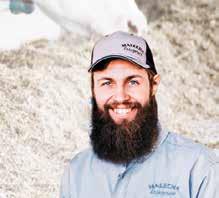

Edgerton, MN Chemical Sales 507-920-8626

Kozlovsky Dairy Equipment
Kaukauna, WI •920-759-9223
Weston, WI • 715-298-6256
Fuller’s Milker Center, Inc.
Richland Center, WI • 608-647-4488
Midwest Livestock Systems, LLC
Zumbrota, MN • 800-233-8937
Menomonie, WI • 715-235-5144
J Gile Dairy Equipment, Inc.
Renner, SD • 800-705-1447
Kozlovsky Dairy Equipment
Midwest Livestock Systems, LLC


Monroe WestfaliaSurge

Monroe, WI • 608-325-2772
Preston Dairy Equipment Sparta, WI • (608) 269-3830
Central Ag Supply Inc.
Stanley Schmitz, Inc
Juneau, WI • 920-386-2611
Baraboo, WI • 608-356-8384
Stanley Schmitz, Inc.
Chilton, WI • 920-849-4209
Tri-County Dairy Supply
Eastern Iowa Dairy Systems
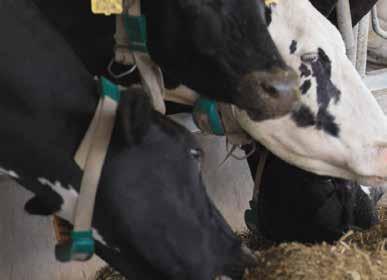

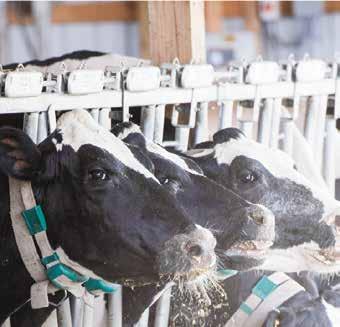

Monroe Westfalia Surge
Epworth, IA • (563) 876-3087
Preston Dairy Equipment
Tri-County Dairy Supply
Janesville, WI • (608) 757-2697
CowScout™ has improved our pregnancy rate by 7%